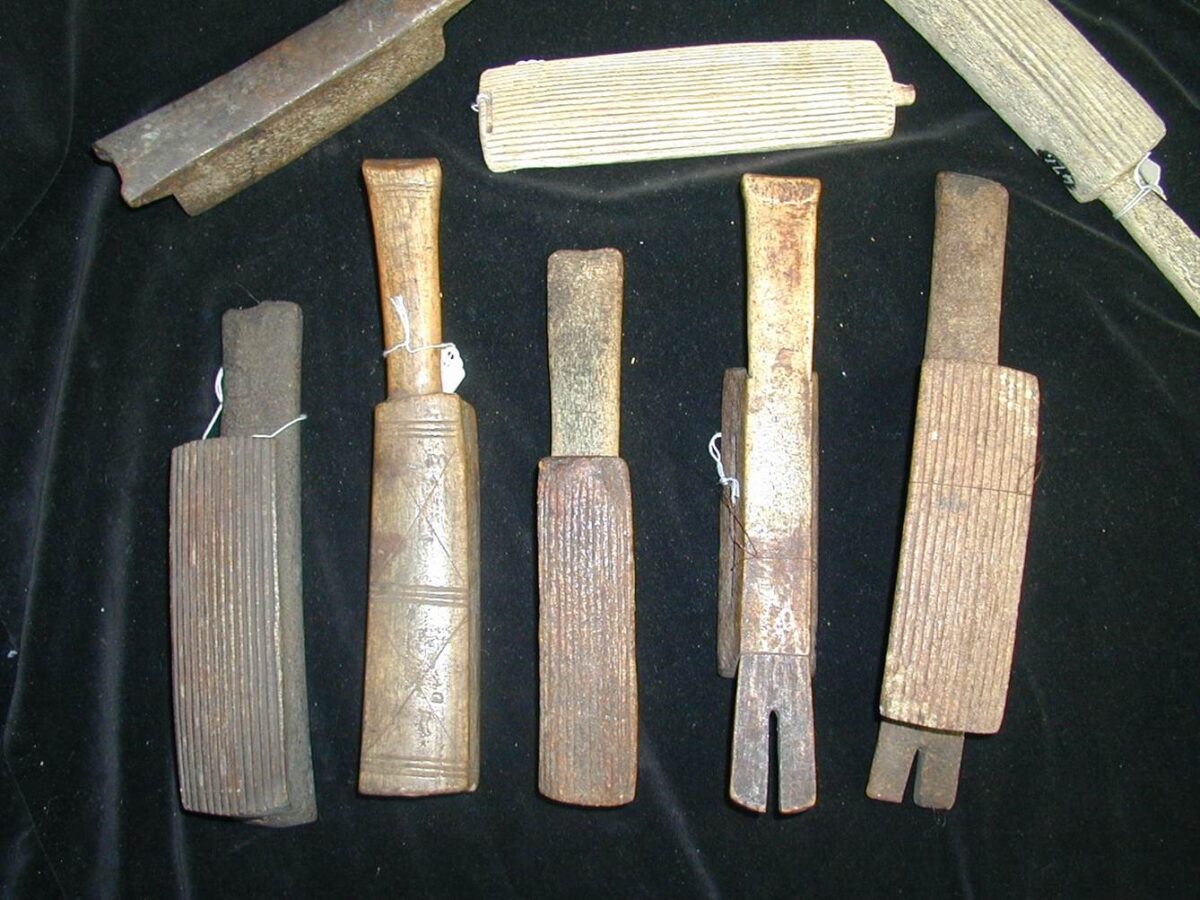Were they Introduced from Polynesia?
Preface
Over the years from the 1970s to 2000, I had interesting discussions with Thor Heyerdahl during his research visits to the Royal B.C. Museum. I came to have a good understanding of his changing philosophy. Thor began his interests in British Columbia when he visited Bella Coola in 1939-1940 to compare petroglyphs at Thorsen Creek with Polynesian art forms. Unlike some of his critics, I read his scientific publications as well as his popular books. He was, on occasion, dismissed in the academic world, for some of his ideas that he had long given up. I assisted Thor in examining Museum artifacts he was interested in for possible Polynesian connections and suggested some myself that needed further research (Figure 1). After I last saw Thor on March 10, 2000, Thor was intending to finish writing an up-date of his 1952 book, American Indians in the Pacific: The Theory behind the Kon-tiki Expedition. He died April 18, 2002, before he could complete this.
In his memory, The Thor Heyerdahl Institute produced a publication: Thor Heyerdahl’s Kon-Tiki in New Light (Hoëm (ed.) 2014). I wrote one of the chapters: Cultural Connections Between Polynesia and British Columbia? I could not include enough of what I wanted in a single chapter, so I intend to follow-up in more detail with the various kinds of artifacts I mentioned. Here, I will cover the topic of Bark Beaters, which will focus on those I examined in the collections of the Royal B.C. Museum and those on-line collections from many American and European Museums for comparative purposes. It is clear that the subject of bark beaters in British Columbia is more complex than previously assumed.
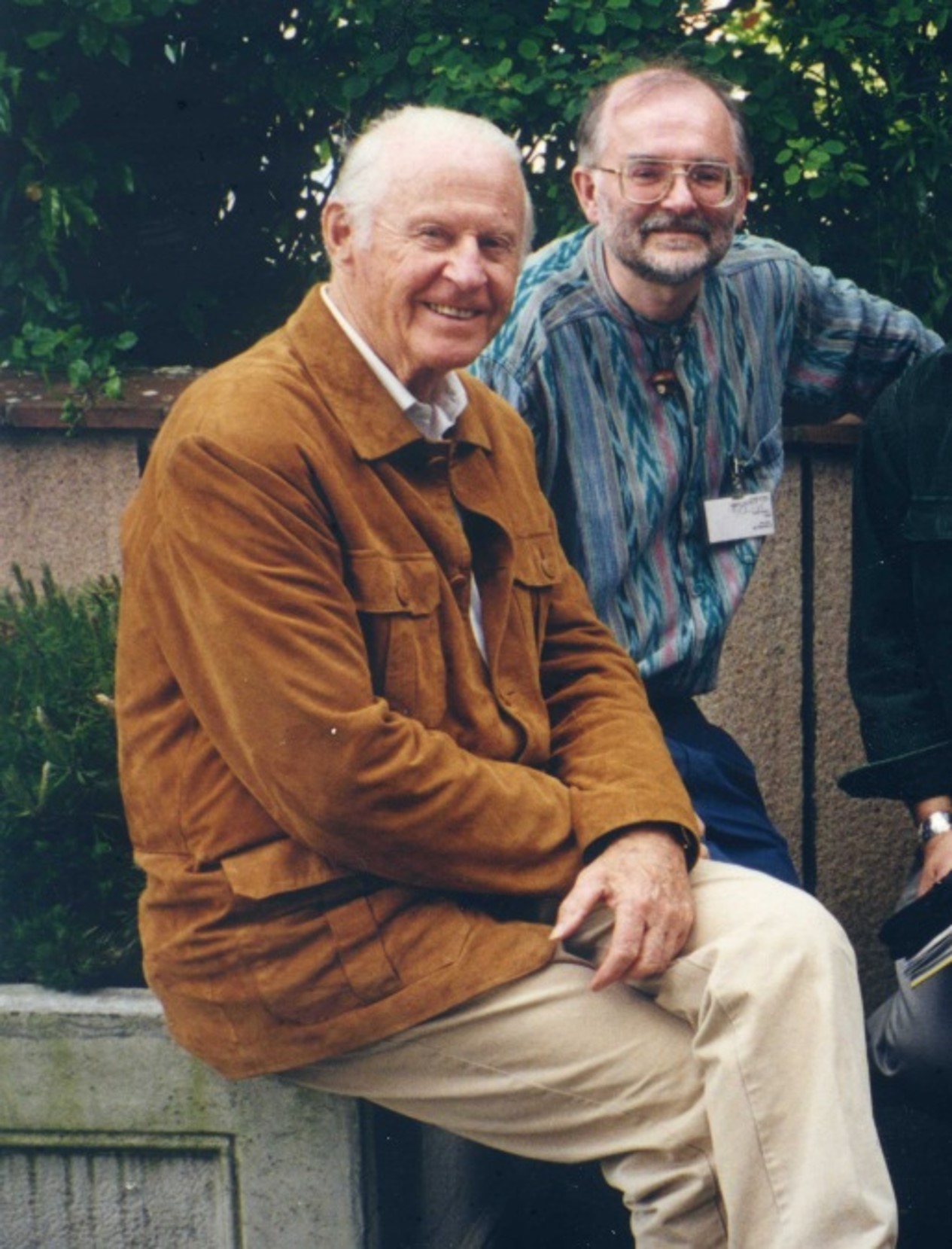
Introduction
If we were to look for possible connections between Polynesia and the coast of British Columba, it would most likely be after the time that human cultures appeared in the outer eastern Islands of Polynesia. The Marquesas Islands were first settled between about 1160 and 1266 (Rolett and Dye 2024).There is no compelling evidence that eastern Polynesia was colonized prior to the eleventh century (Weisler et. al. 2023; Anderson et. al. 2019; Allen 2014).
In America the practice of using bark beaters in making bark cloth lasted through the Classic (250-900 A.D. and Post Classic (900 A.D. – 1521 A.D.) periods in Mexico, where in later times, bark cloth was used for book making by the Aztecs. Paul Tolstoy undertook an extensive examination of the possible relationship between bark cloth and beaters of two different styles (Figure 2), in Mesoamerica 2500 years ago and similar ones appearing in Asian technology 4000 to 5000 years ago (Tolstoy 1963; 1991; 2008). Tolstoy was suggesting that Polynesian “papermaking” branched off the common “family tree” of East Asian papermaking technologies very early on, and continued as a separate tradition. This “separation” may have taken place as early as 3,000-2,000 years B. C. The movement into eastern Polynesia did not happen until much later. The main point Tolstoy was making, is that the numerous detailed similarities in paper making in Indonesia and Mesoamerica indicate there must have been early cultural connections between the two areas.
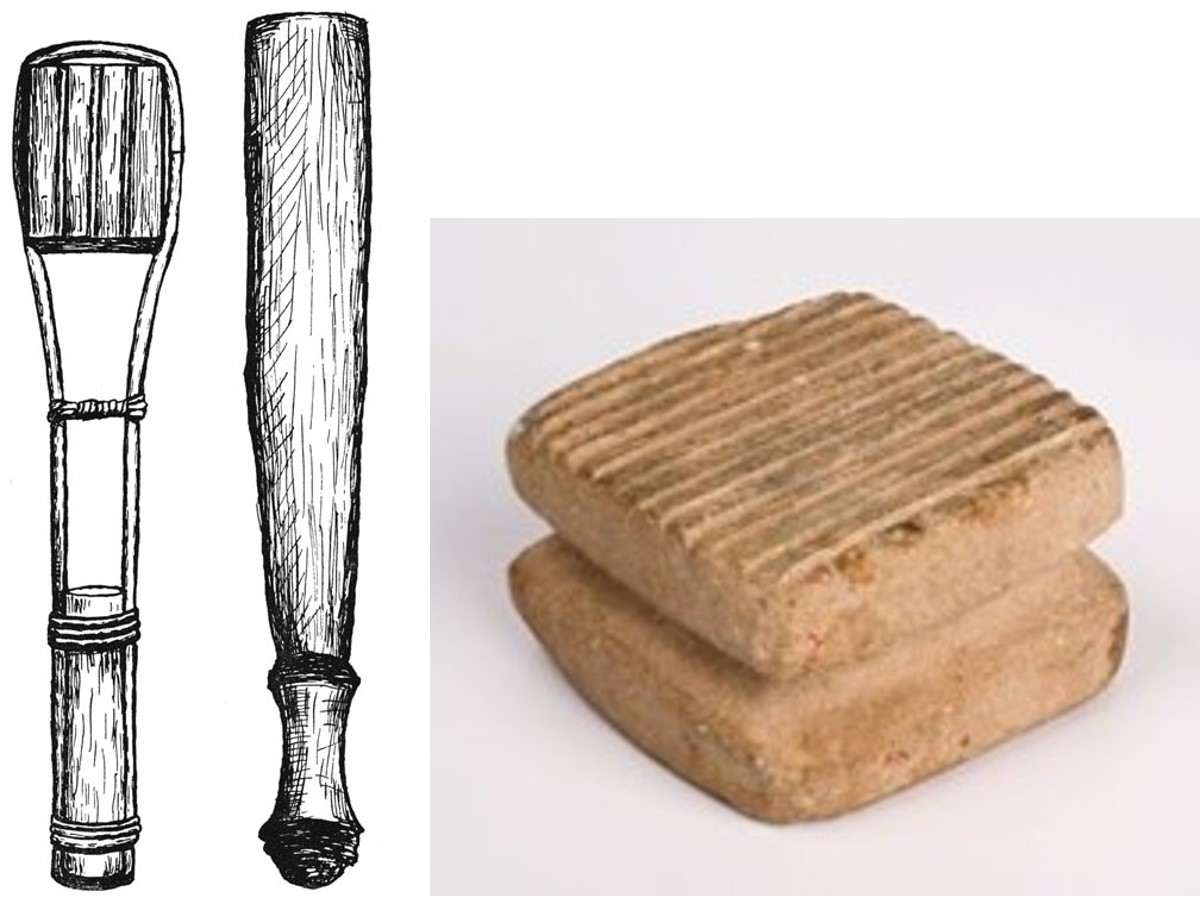
In Appendix I, I will present an overview of Tolstoy’s ideas, in his own words, about the bigger world view regarding paper making and bark beaters. In his very detailed research, Tolstoy intentionally left out bark beaters that appear in both eastern Polynesia and on the Northwest Coast of North America. Tolstoy seemed to be unaware of the extent of bark beater use in British Columbia. This is likely because so little has been written about them.
In explaining, why he left out the eastern Polynesian bark beaters Tolstoy stated:
“Contrary to what some might expect, Polynesian tapa making – perhaps the most elaborate set of procedures ever devised to make bark cloth – does not provide a credible link between the Indonesian and Mesoamerican technologies. … Polynesian tapa making has its own distinctive characteristics, such as the use of the hollow wood anvil, and lacks many key features that link Java and Sulawesi to Mesoamerica, notably the unique racquet beater with a stone head (figure 2 ), unknown in the Pacific east of the Philippines” (1991:13).
The “unique racquet beater” (Figure 2), that Tolstoy mentions was not used in Eastern Polynesia or British Columbia. It is the latter areas that will be my focus of description and commentary here.
Bark Beaters in British Columbia
Bark Beaters. Not just Material Objects.
To the Nuxalk (Bella Coola) people, of the central coast of British Columbia, there is a supernatural Barkbeater: “In the Land above there lives a supernatural woman who spends all her time pounding cedar bark as used, either dyed or undyed, for ceremonial objects of different kinds. Her name is Sþikþiknum di Sunxãlatta and she is a patron of various Kukusiut”. This is a reference to the winter dances where each dancer “portrays a performance given by one of the Supernatural beings in the house above” (McIlwraith 1948).
In Indigenous cultures, as in all cultures, material objects are often linked to complex aspects of social life. It is important to know about these material objects and their design, which might tell a larger story of connections. The fact that whale bone bark beaters have a whale tail design suggests a deeper meaning.
Bark Beater Uses.
Bark beaters are used to pound cedar bark (Figure 3), which is soaked in water to further separate and soften the fibers. This prepared material can then be made into clothing such as skirts, hats and capes, bedding, cords and a variety of articles used in various ceremonies.
I would propose that the physical similarity and dating of bark beaters in Polynesia and the Northwest Coast may suggest late period cultural connections between the two places. Bark beaters appear in the outer Islands of Polynesia as late as about 1250 A.D. It is around this time that they appear on the S.W. coast of British Columbia. I will describe all of the examples in the Indigenous collections (ethnology and archaeology) of the RBCM, so there will be greater awareness for others to examine this question.

Bark processing in British Columbia and Polynesia
Polynesia
In Polynesia, Kapa bark cloth was made mostly with the wauke or paper mulberry, but also the mamaki and breadfruit tree and two species of raspberry bushes. It was used for making clothing, bedding, burial wrappings and lamp wicks. Bark beating was often a communal activity, as seen in figure 4.
William Ellis, a Surgeon, on Captain Cook’s ships from 1776-79, observed that bark cloth was of great importance in Hawaii. He noted that, although mats were usually not more than six feet wide by nine to twelve feet long, very large ones could be twelve feet wide by sixty to one hundred feet long. The latter were only made for the high chief. They were hung from the chief’s house rafters for the purpose of displaying his wealth and number of dependants.
The tree bark was removed using scrapers made of shell or turtle bone. After the bark had been peeled from the tree, the inner bark was separated and soaked in sea water for a week to make it soft and pulpy. Strips were then placed on a stone anvil and beaten with a cylindrical wooden beater or hohao, these might be either smooth or grooved. The strips were then bleached in the sun, before re-beating. Sometimes pieces were shredded and made into balls. The balls were covered in leaves and allowed to ripen for a week. Following this came the final beating. A raised wooden hardwood anvil, about 165cm long and 9cm wide, had a V-shaped groove cut along its inside length. In use the anvils rang with what was considered a pleasant hollow sound (Ellis 1782).
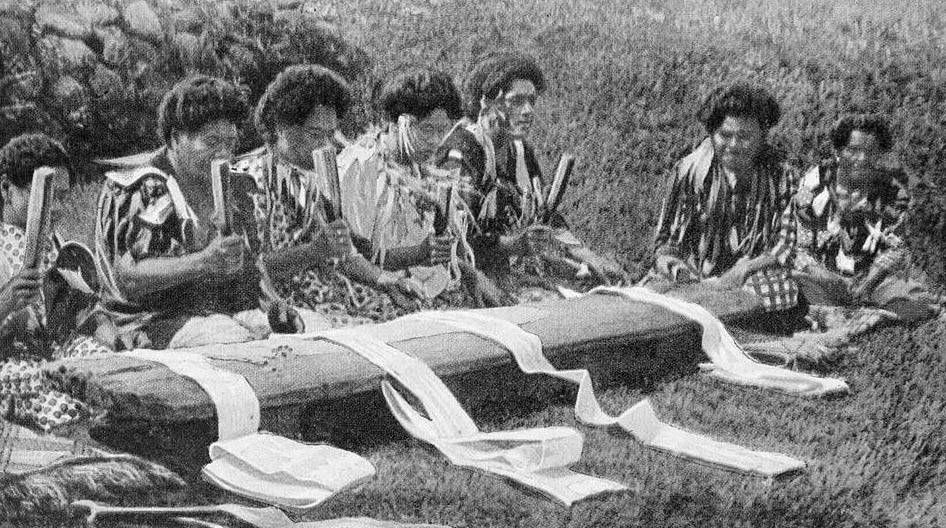
Beaters used in the final stages were square in cross section. One side had a wide edge used to break up the bark fibres, another with finer grooves was then used to pound the edges of the strips together and form larger pieces of tapa. Carved geometric patterns occur on one to four faces. The patterns left the equivalent of a water mark on the tapa. Finally, the tapa was spread out and dried in the sun. The many carved design patterns represented objects such as nets, sharks teeth, the backbone of an eel, a leaf of a fern, a coconut frond, the fruit of the pandanus and the motion of an earth worm (Brigham, 1911; Buck 1957; Feher 1969; Kooijman 1972).
I have observed that there is a bias in discussing and showing images of the Polynesian beaters with more elaborate designs (figure 5), when it appears that the beaters in earlier times had a series of straight cut grooves on one side only, similar to those from British Columbia. It was later that the more complex patterns developed. I have observed only one example in British Columbia that shows a cross-hatching pattern on the usual style that only involves a row of straight cuts. This example, figure 6, is found in the Courtenay Museum on Vancouver Island. An image of it was provided courtesy of Catherine Siba of the Courtenay Museum.
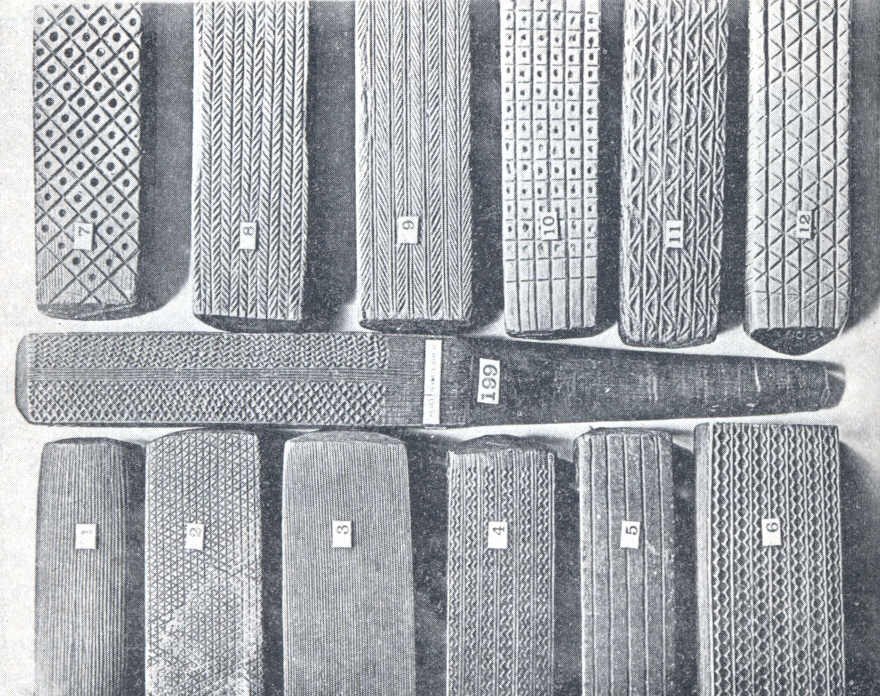

British Columbia
The making of bark cloth was an involved procedure in both the southern coast of British Columbia and in Polynesia. The similarities between these regions were commented upon by several Explorers in the late 1700s, who made comments about cloth making and the bark beaters. At least eight bark beaters were collected during the Cook expeditions of the late 1700s (Kaeppler 1978).
The best descriptions of the processing of bark, however, were provided later by anthropologists such as Franz Boas among the Kwakawak’wa of the North east end of Vancouver and adjacent mainland and Philip Drucker, among the Nuu-chah-nulth of western Vancouver Island.
Boas (1909) reported:
“The yellow cedar is peeled about the last week in July. The bark is made to fall on the sap side. It is bent over until the inner bark cracks, which is then pulled off; and the strips of bark, which are about the width of the hand, are folded. These bundles are placed in salt water, at a place where it is always calm, the ends being weighted down by stones. It is left in the water for ten days to a month, until it gets spongy. Every now and then it is tested; and when it is soft enough, it is taken out and put in a pool of salt water on the beach.
Then a mat is spread on the beach; a round stick of yew-wood, or a board as wide as the cedar bark, is laid on it, and while the bark is wet, it is beaten across the fibre, the bark side outward, with a bark beater of bone of whale. The beating surface of these implements is grooved. They resemble in general character the tapa-beaters of Polynesia and of Central America. After being beaten, the bark is hung over poles to be bleached and dried. The outer layer is pulled off, the inner part is dept and put away. Sometimes the fibre is mixed with the red cedar”.
Philip Drucker (1951) reported:
“The bark was folded into bolts about 3 feet long. When the couple or party (sometimes a number of people went together) had all the bark they could carry, they made it up into packs to bring it down to the canoes. The coarse outer bark was not split off when gathered, except for the flat dry scales near the base. At the village the bark was unrolled and put to soak in salt water in a quiet cove. Rocks were put on the strips to keep them from washing away. After some days, when thoroughly soaked and soft, the strips were taken out of the water, laid on an old plank, and pounded with the clublike grooved beater (hisyak) of whale bone, until the inner layers of fiber could be pulled off. These fibrous strips were beaten again with the same implement until well separated. Then they were put to soak for a few days in a box of fresh water (to remove the un-pleasant odor, it was said). Finally, they were wrung out and spread on the beach to dry, so that the short, broken, lengths of fiber could be culled out, and the rest saved to be woven”
RBCM Ethnology Bark Beater Collection
Three Main Styles
There are three main styles of bark beaters on the coast of British Columbia and neighbouring N.W. Washington State (Figure 7). All have a basic rectangular shaped body with rows of carved lines on the bottom and have an elongated handle. Almost all are made of whale bone. Type 1 beaters have an extension, in continuation with the top, that extends out beyond the distal end of the main body The extension is usually bifurcated to form two, rounded or flat topped, ear-like projections. It has a body that ranges from 4.3 – 5 cm. wide with a height or depth that ranges from c. 4.3-5.3cm. It overlaps in size with type 2 but is generally more medium sized in comparison to the other generally thicker or thinner bodies of the other two types. In the centre of the body is a carved out long rectangular slot, 2 to 3cm high and taking up about 1/3rd of the main body height. Type 2 has a main body that ranges in width from about 3.7-7cm, and a height that ranges from 5 to 6.4cm. It is heavier than type 1, in generally having a larger main body part and not having a cut out slot in the middle. The handle is usually flat in line with the top and has a slight to distinct whale tail design on the proximal end. The third type, although being wide. has a much thinner, 2-3cm, body height and more paddle-like in cross section. It does not have decorative features other than a rare knob on the end of the handle or protruding from the distal end.
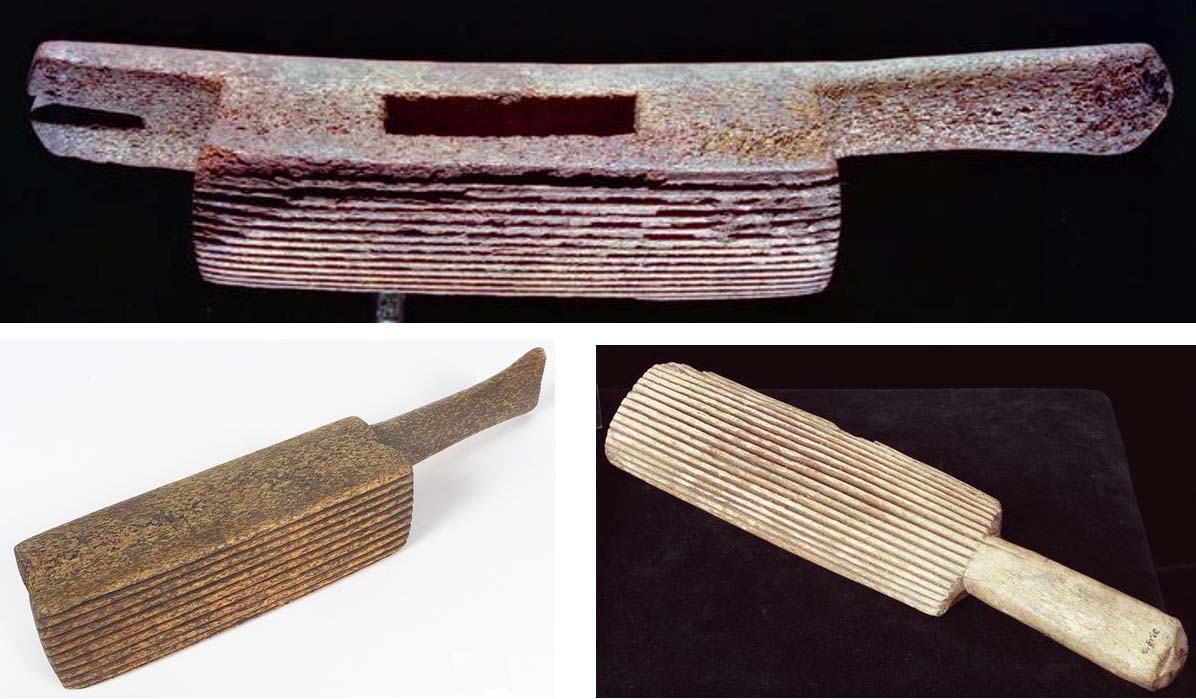
Figure 7. The three main styles of whalebone bark beaters in coastal British Columbia.
Different styles for Different Functions?
Raymond Kennedy’s 1934, detailed description of bark cloth making in Indonesia, indicates the use of a variety of bark beater styles and sizes. It is likely that a similar, but less extensive, pattern was present among Indigenous cultures of British Columbia. Kennedy describes the beaters: “Suffice it here to say that they are of various sorts, running a whole gamut of size, shape, design, and weight. The generic term for beater among the Toradja is ike, which is the name used throughout Polynesia. The handling of paper-mulberry bast is slightly different from that of the rougher sorts of material. The strips of the former are beaten with a heavy hammer (pombayowo) before they are laid upon each other to be felted together.
The heaviest hammer, the pombayowo, is used in the first stages of felting. When the strips have been beaten together for some time, the whole sheet is folded over several times and beaten further with finer hammers. This folding-over saves time and also prevents the punching of holes in the rapidly thinning sheet. Care is taken that the folded material does not stick together, and water is sprinkled over it continuously, so that it will not split from dryness. A fine headcloth may be beaten an entire day to procure the desired thinness.
Every beater-head has a different arrangement of grooves on each side, and the fuya-maker has a kit of many beaters, each one used in a different stage of the manufacture of the cloth. The beater with the largest grooves is first used, and as the cloth comes nearer and nearer to completion, beaters with finer and finer grooves are employed. The first and largest beater has three vertical grooves on one side and seven to nine on the reverse. The side with the three grooves, … has a special name (pombayowo), as does the other side, which is called pongkakagi, meaning “felter.” It is this latter surface which is used in felting the strips” (Kennedy 1934).
The RBCM Collection
I will summarize the bark beaters in relation to different linguistic or cultural regions. There are adequate numbers, mostly for the Nuu-chah-nuth and Kwakwaka’wakwa territories, both in the RBCM and other museums, but less for the other areas. There are likely collection biases resulting in the numbers that end up in Museum collections. For example, the seven beaters for the Heiltsuk and Nuxalk territories were all collected in 1895, by one person, Fillip Jacobsen, of Germany. I am including here, examples of bark beaters from other museum collections, where they are lacking from cultural populations in the RBCM collections. These include only a few examples from the Haida, Haisla, Tsimshian and Tlingit.
It was not uncommon for artifacts purchased from Indigenous individuals to have been ones found by them eroding out of shellmiddens. If they were in reasonably good shape, they once ended up being kept in the ethnology collection, after the anthropology collection separated to form a second archaeological Division collection. Several ”ethnographic” bark beaters are of an archaeological nature. The latter are noted. There are a number of examples from museums around the world where the provenience of the bark beater is wrong or likely to be wrong. This is true of the British Museum artifact Am.NWC.48, mistakenly listed as being from California. An important scenario here is when Polynesian artifacts are mistakenly assigned to Indigenous cultures in British Columbia. This may occur when the people entering old catalogue information to computer systems are lacking in knowledge regarding the material culture of these two areas. The provenience of wooden bark beaters from old collections can now be confirmed or denied by DNA analysis.
Nuu-chah-nulth Bark Beaters
RBCM10226. Nuu-chah-nulth. Moachaht. Type 2. Whale bone. Whale tail design on handle. Collected by Walter A. Anderson and purchased from his son J.R. Anderson by Charles Newcombe. Part of Newcombe collection acquired by the Provincial Museum in 1961.
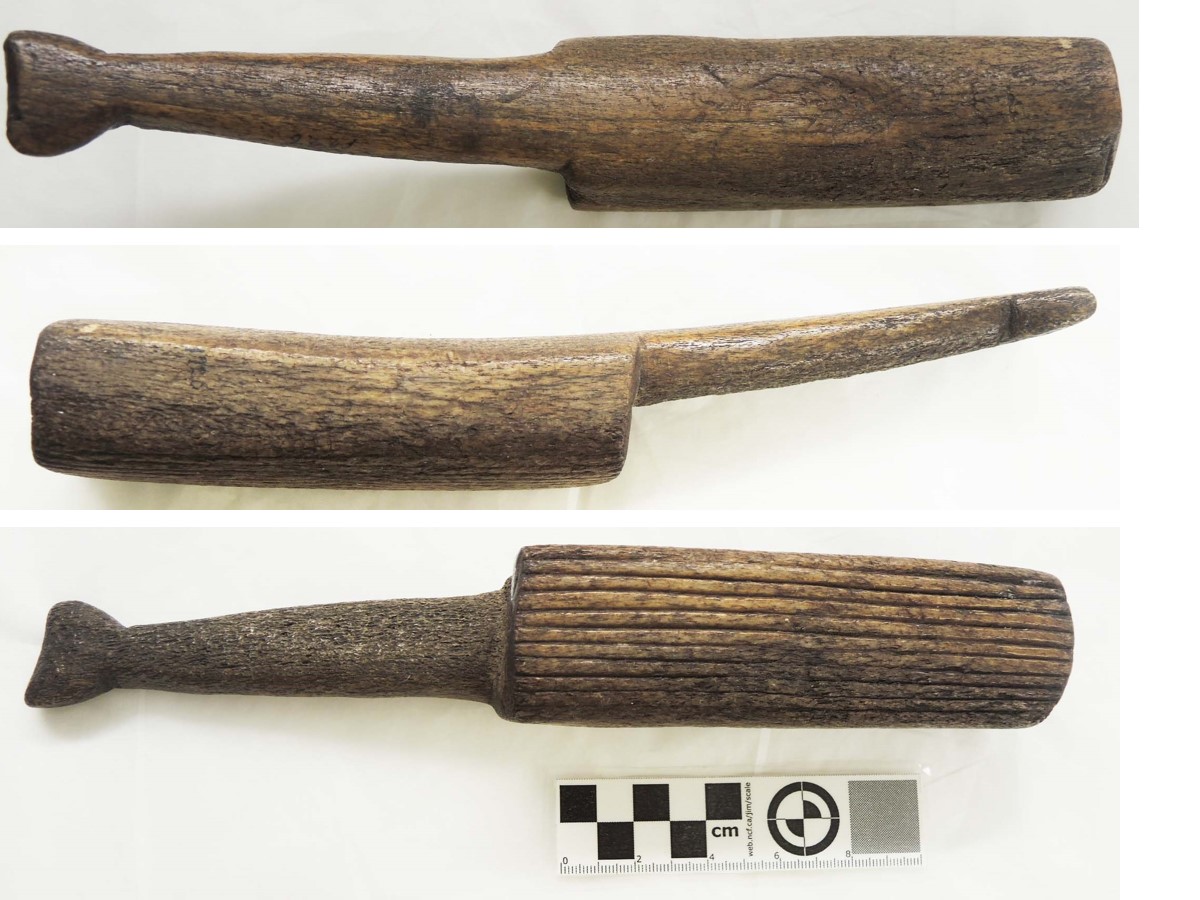
RBCM9873. Nuu-chah-nulth. Moachaht. Type 2. Whale bone. Collected by Charles Newcombe in 1914.
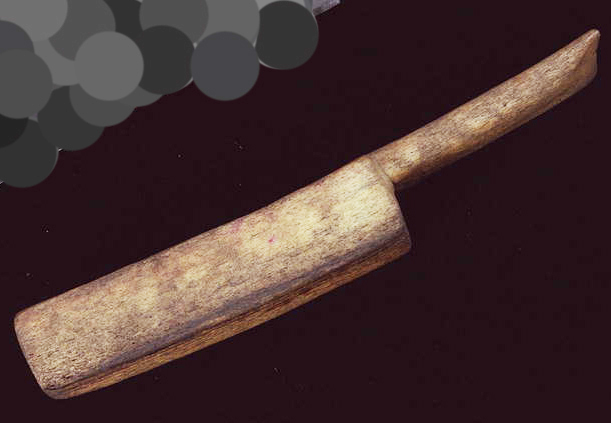
RBCM467. Nuu-chah-nulth. Whale bone. Type 1. The distal squarish end of the top extends out past the body but is not bifurcated into the ear-like projection. Collected by Fillip Jacobsen in April 1893.
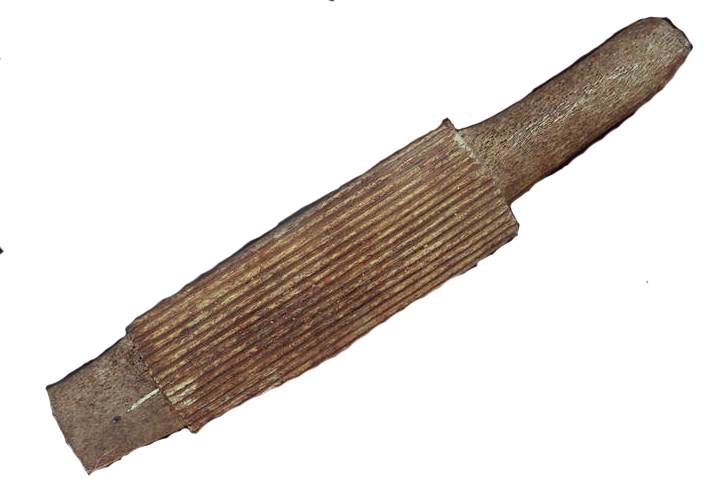
RBCM4787. Nuu-chah-nulth. Hesquiaht. Hot Springs Cove, Refuge Cove. Type 2. Whale bone. Rectangular handle. “Whale bone mallet. T H Clarke Refuge Cove”. This is obviously an Archaeological specimen based on its extensive wear and erosion.

RBCM16367. Nuu-chah-nulth. Whale bone. Type 2. Not on database. Type 2. The poor condition suggests it was an archaeological find. Small drilled hole in handle, appears to be recent to hang it up.
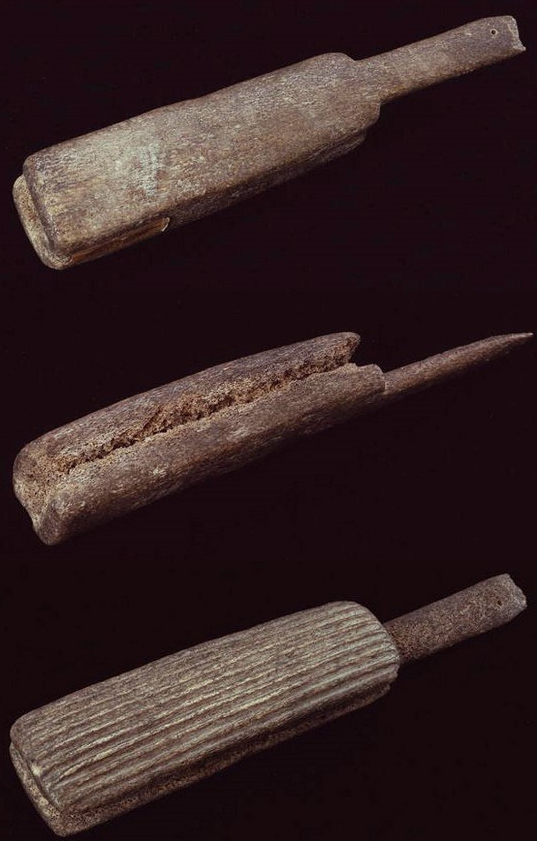
Figure 13, shows 12 examples of Nuu-chah-nulth Type 2 beaters. from the Canadian Museum of History collection. Note extent of whale tail designs on proximal end of handle of some and distal whale tail protrusion on upper left example.
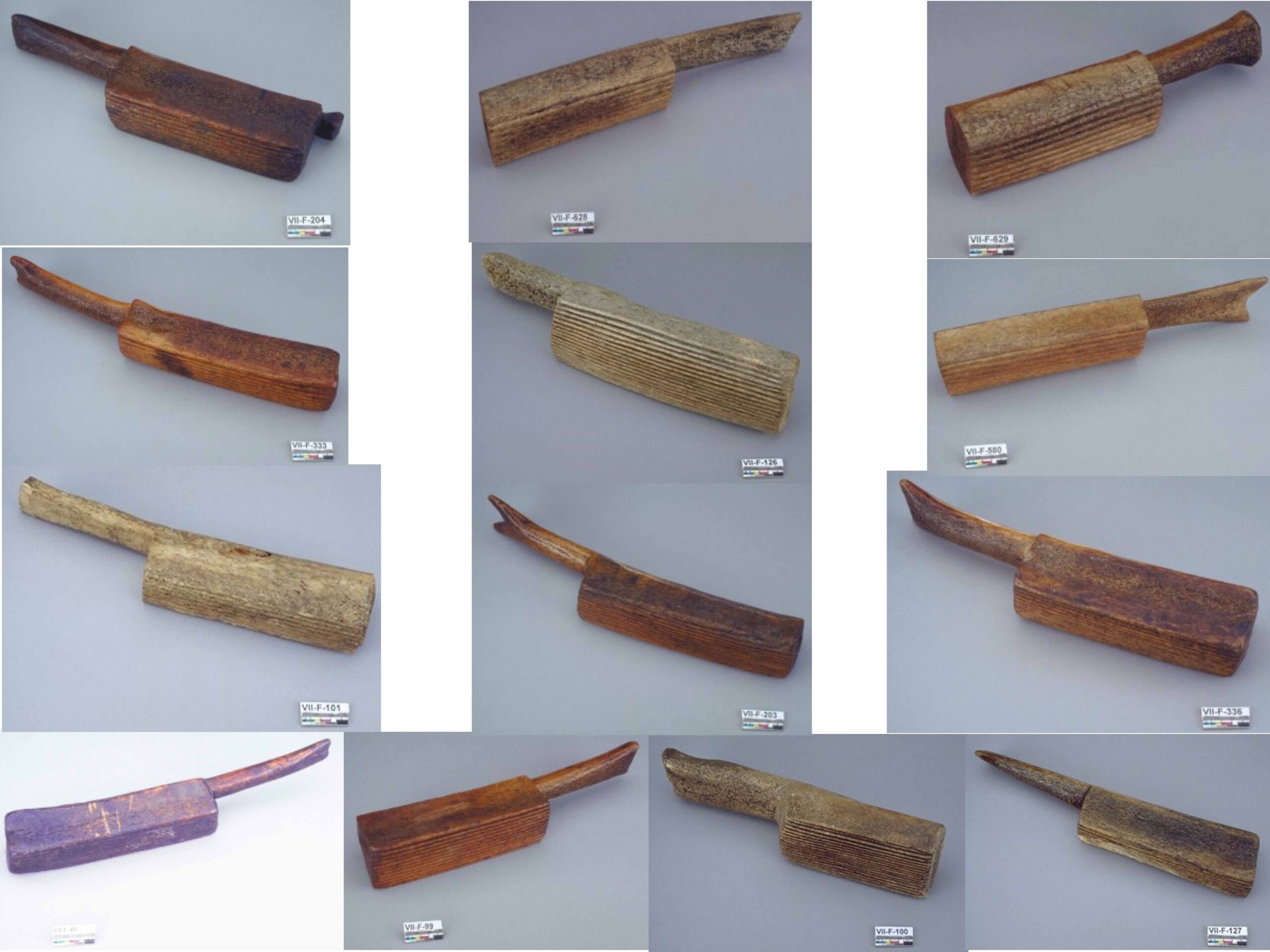
Kwakwaka’wakw Bark Beaters
RBCM471. Kwakwaka’wakw. Nimpkish River. Type 2. Whale bone. This is an archaeological example. It was “Dug up in old village by A.W. Huson in 1894”. Donated by G. Huson. 1894-1896.
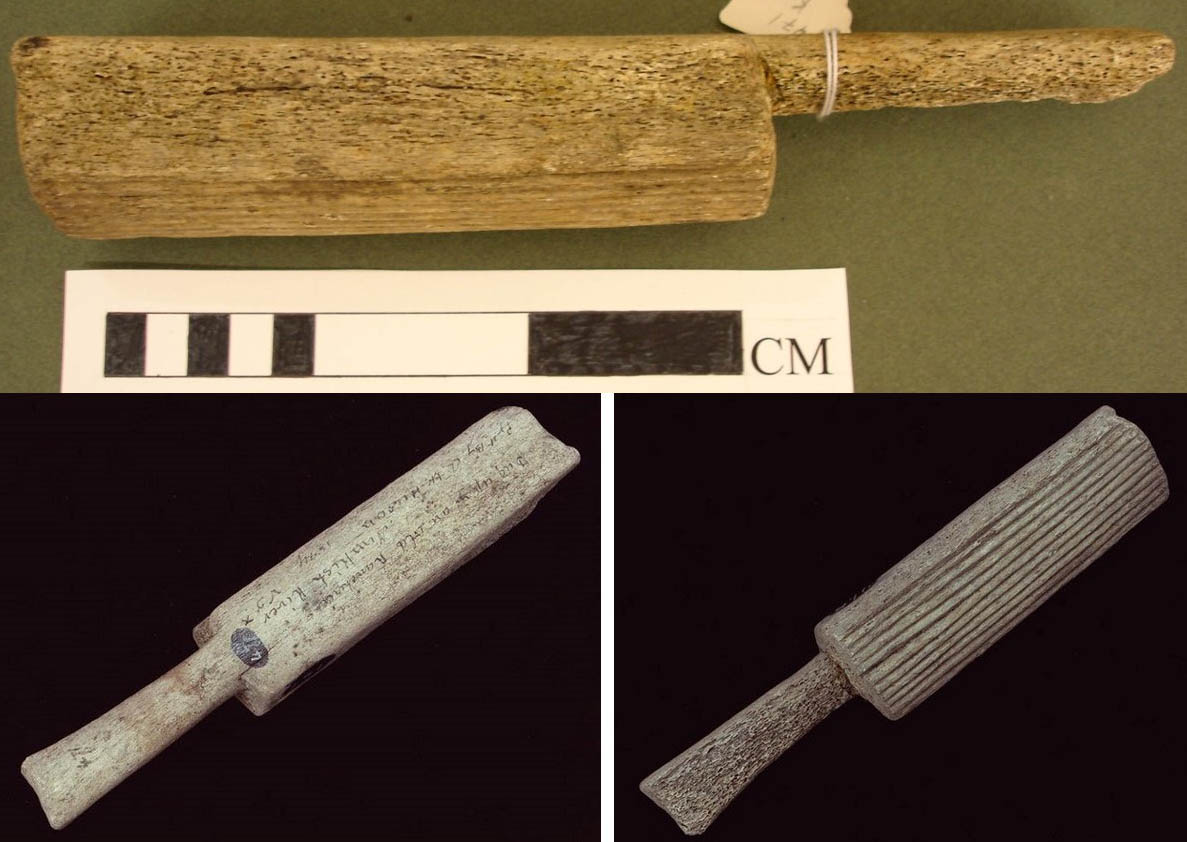
RBCM9552. Kwakwaka’wakw. Gwasilla. Type 2. Whale bone. Collected by Charles Newcombe about 1905 (Newcombe Estate 1960).
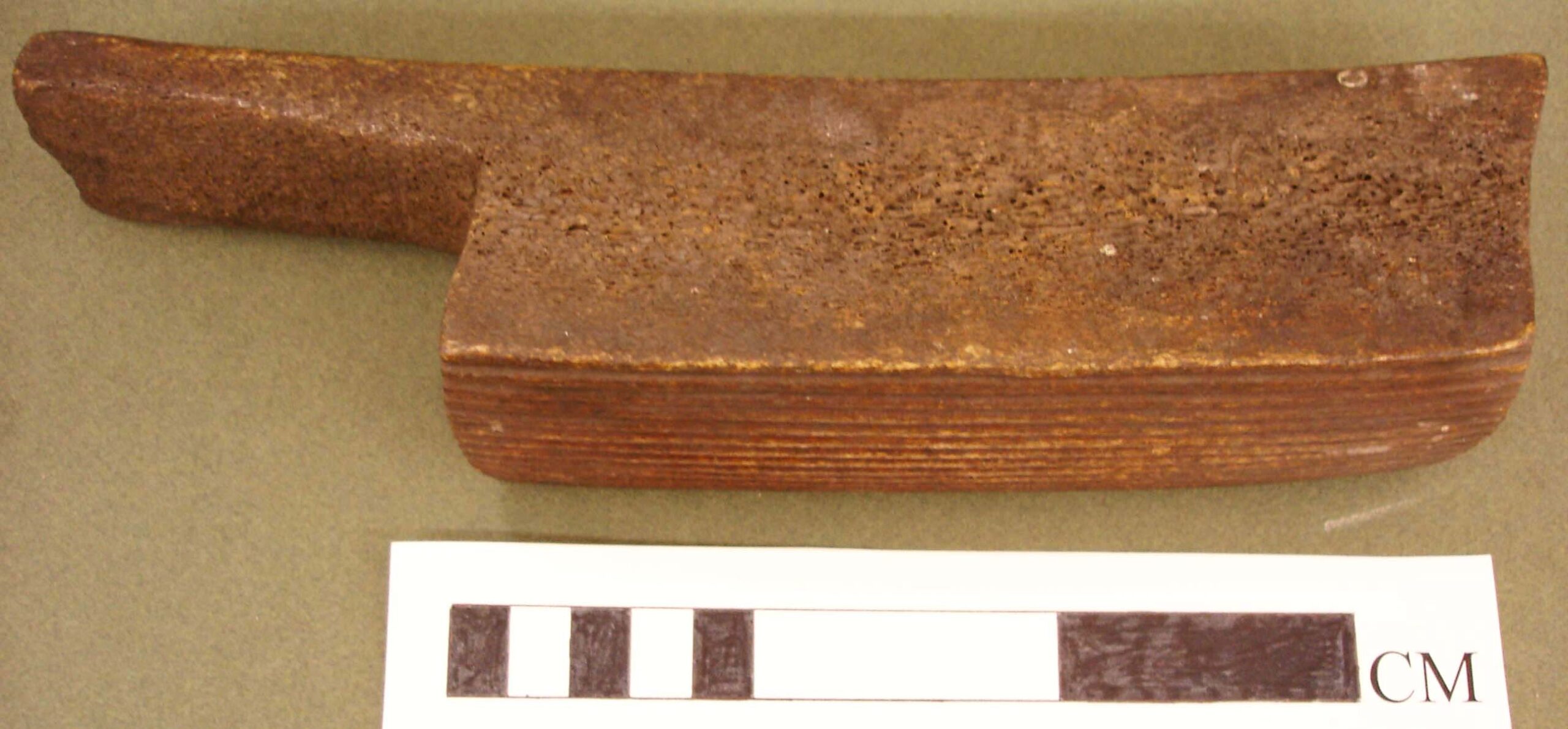
RBCM9553. Kwakwaka’wakw. Gwasilla. Type 2. Whale bone. The upper distal surface extends out slightly with two rounded points. Collected by Charles Newcombe about 1905. (Newcombe Estate 1960).
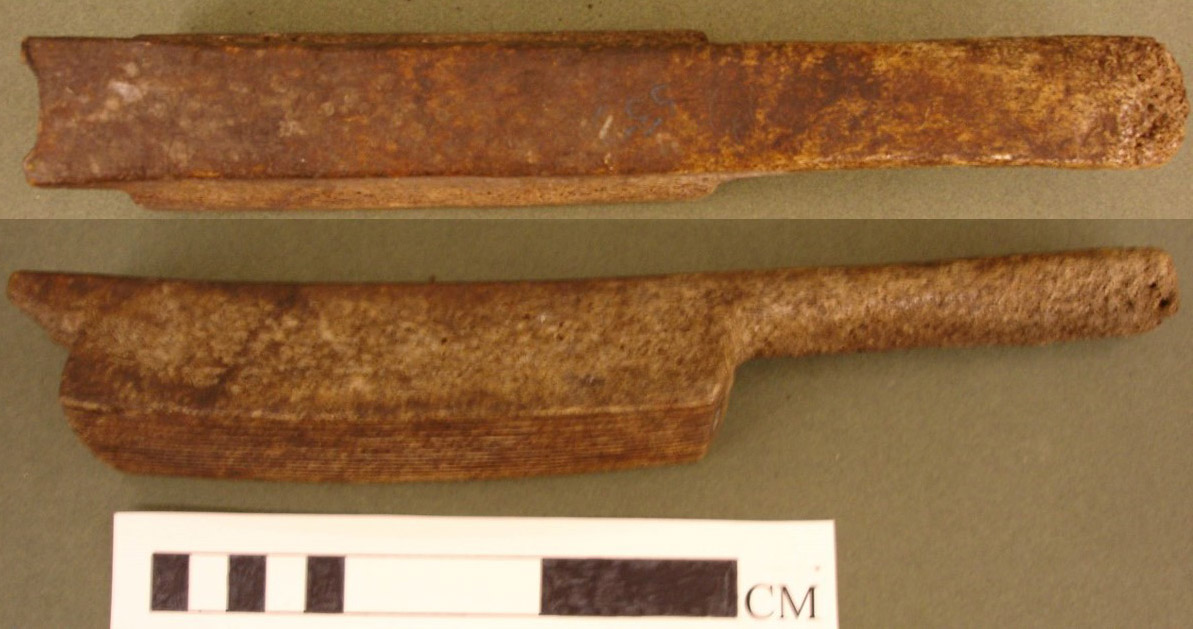
RBCM9609. Kwakwaka’wakw. Tenaktak. Knight Inlet. Type 2. Whale bone. The top surface has four sets of three parallel incised lines. One extends across the handle and three across the top on the main body near each end and across the middle. The latter extend down the sides of the body. Collected by Charles Newcombe. 1917 (Newcombe Estate 1960).
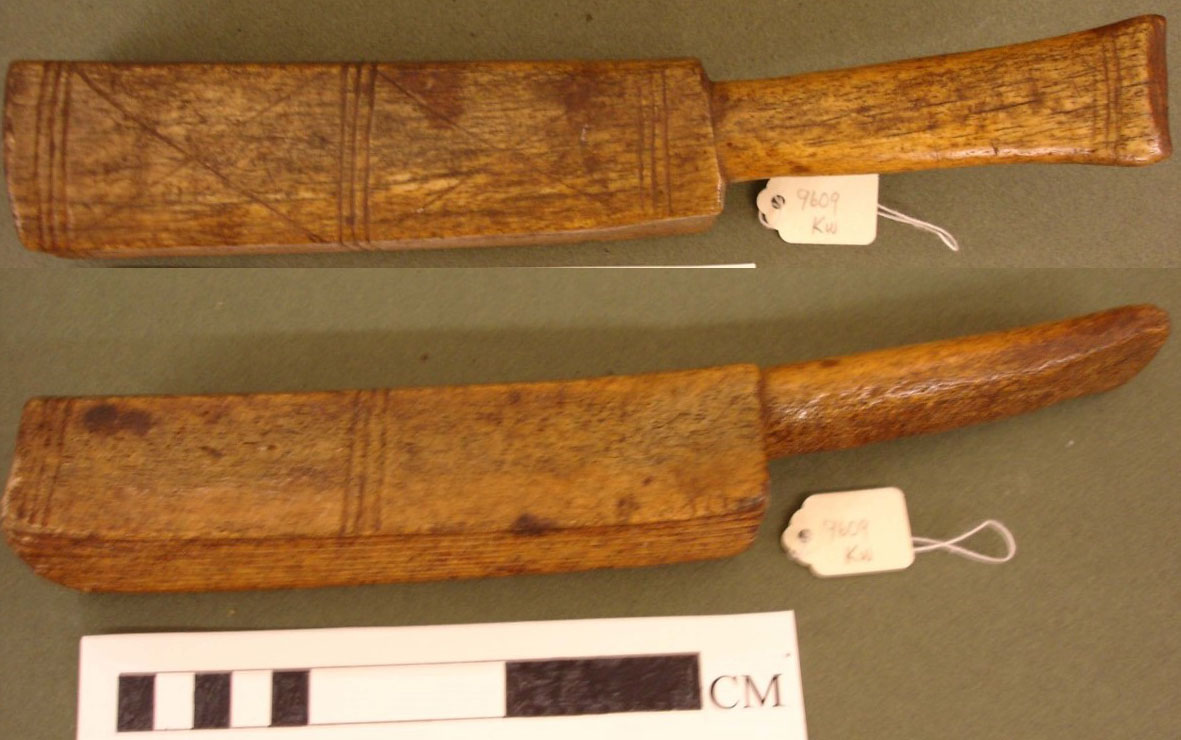
RBCM9876 Kwakwaka’wakw. Type 2. It only has a slight whale tail shaped design on the end of the handle.
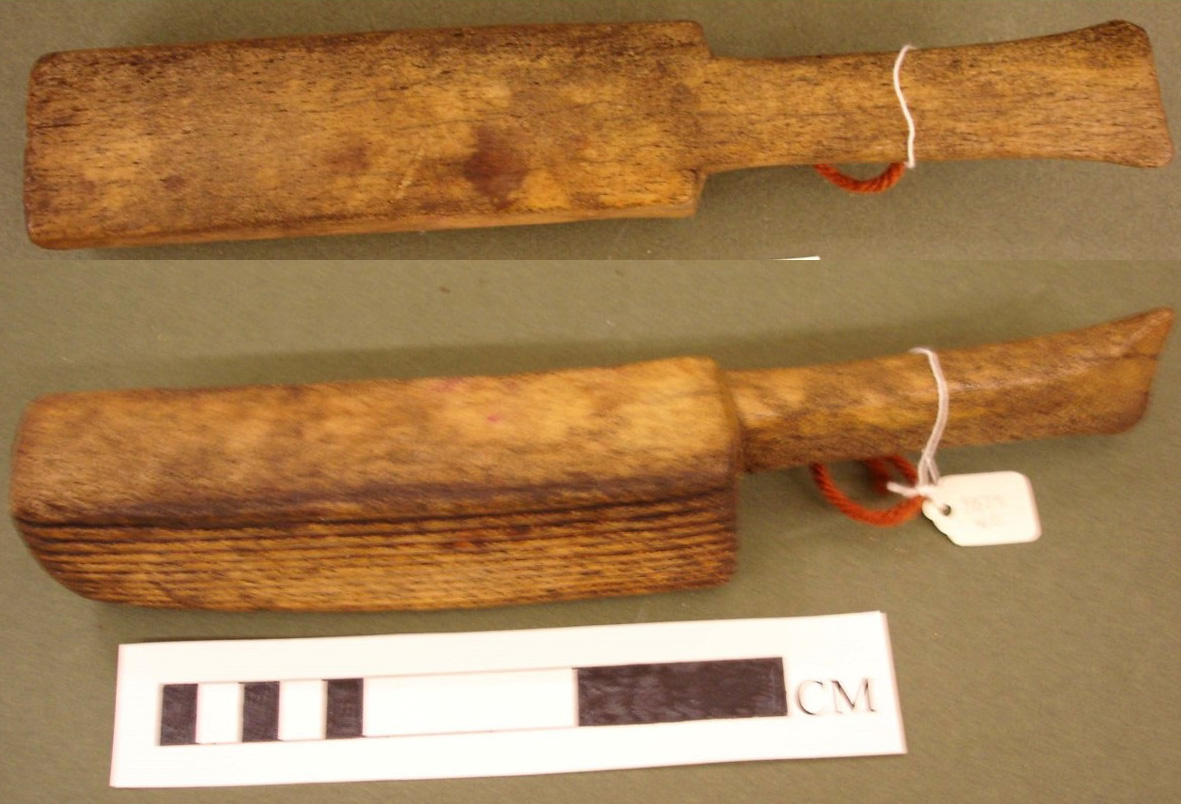
RBCM12695. Kwakwak’wakw. Quatsino. Type 3. This is a unique thin bodied example with no handle present. It has two holes at one end which may have been for the attachment of a handle or for the attachment of a thicker top section. It has a larger number of raised ribs than most beaters. On the bottom portion the two drilled holes are joined by an inset groove. There is a small nub on the end opposite the hole end that may also have been for tying onto another part of the beater. This example has a larger than usual number of about 20 raised grooves. Acquired 1966.
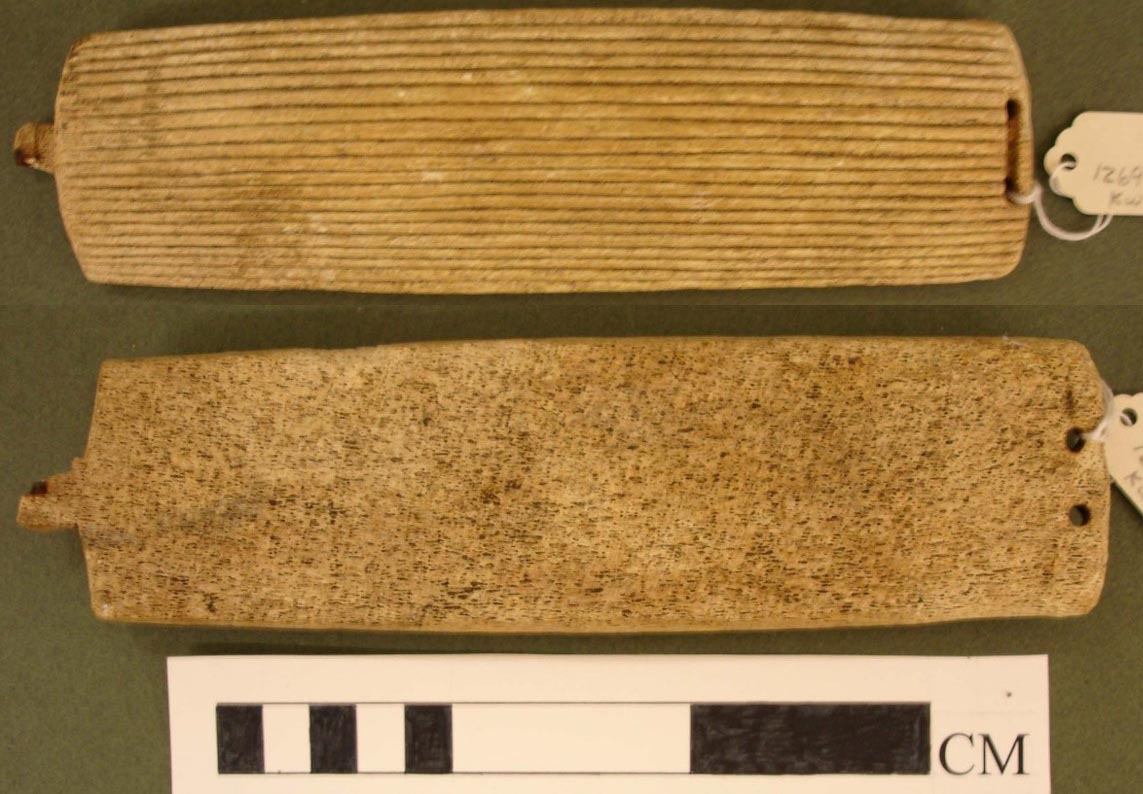
RBCM16364. Kwakwak’wakw. Type 2. Whale bone. Address on label “Wm Lock Paddon. 94 Linden Ave. Watsonville California”. Data base has “Nuu-Chah-nulth”.
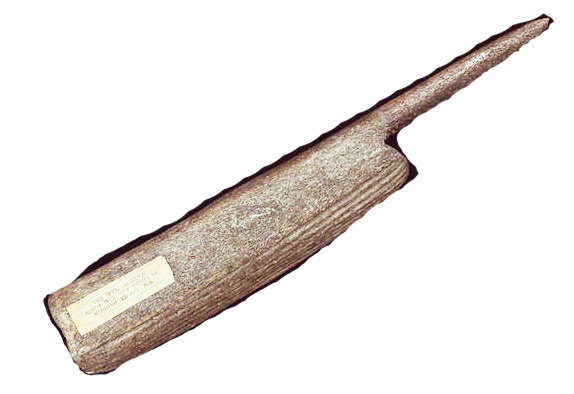
Figure 21, shows five type 2, Kwakwka’wakw bark beaters, from the Canadian Museum of History collection. The upper example differs in having a whale tail design extension on its distal end and the two, immediately below, have top designs, similar to type 1 beaters, but have no central elongate holes. The latter may be unfinished Type 1 examples.
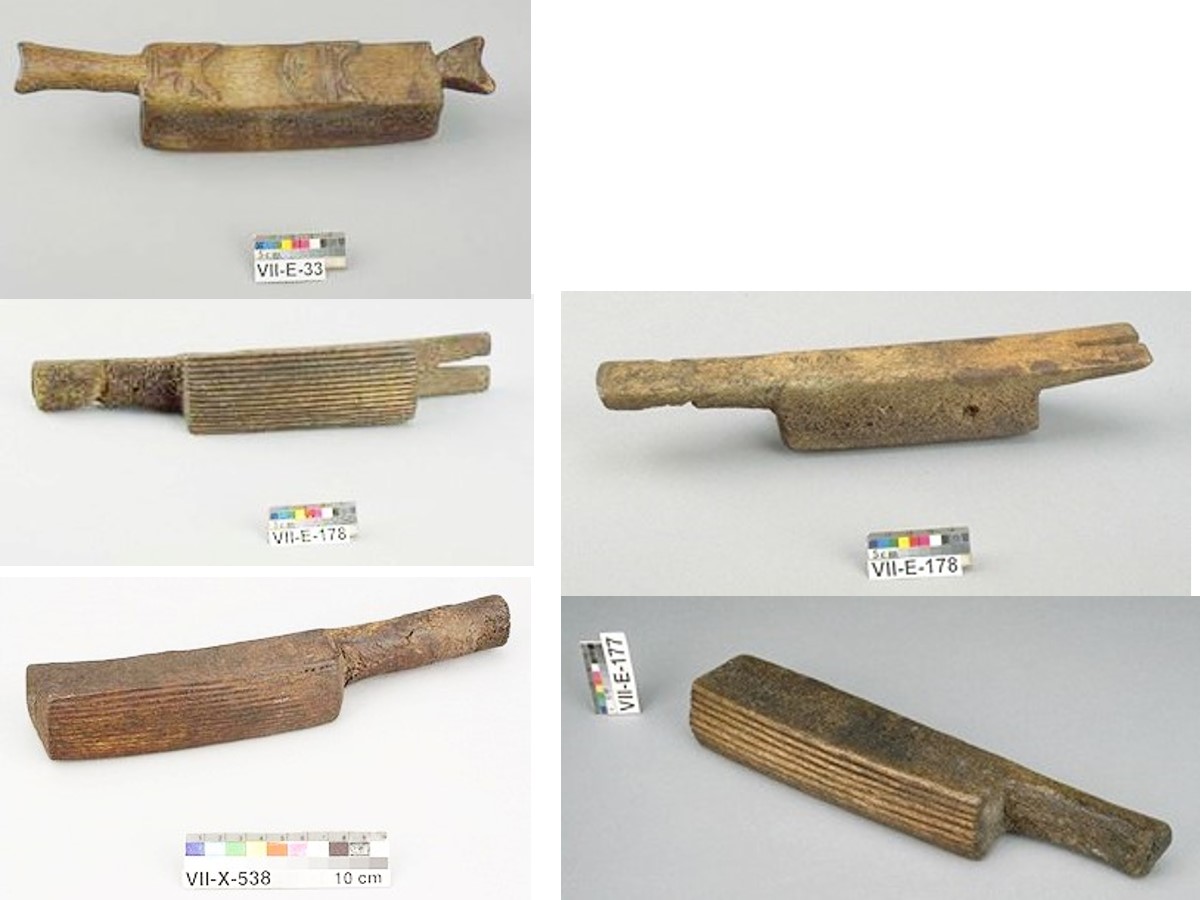
Figure 22, shows a sample of the, at least twenty, Kwakwka’wakw bark beaters in the U.S. National Museum of the American Indian. This will show the greater variations within the beater types. The upper left group image beaters are from the Wuikinuxv (Oweekeno) territory.
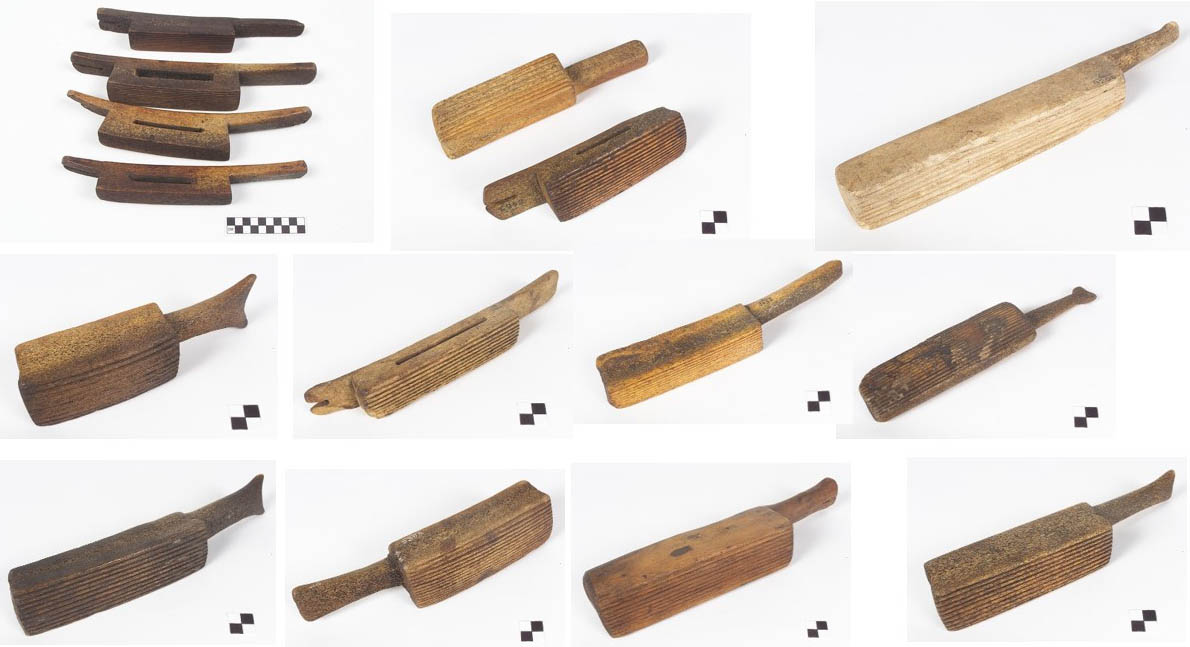
Heiltsuk Bark Beaters
All of these, as well as some in German museums, were collected in 1893, by Bernard Fillip Jacobsen (1864-1935). There are three type 1 beaters and one type 2. A similar Type 1 example is 1/3850, in the U.S. National Museum of the American Indian, collected by George Emmons in 1922.
RBCM463. Northern Wakashan. Heiltsuk. Bella Bella. Type 1. Whale bone. Collected by Fillip Jacobsen, April 1893.
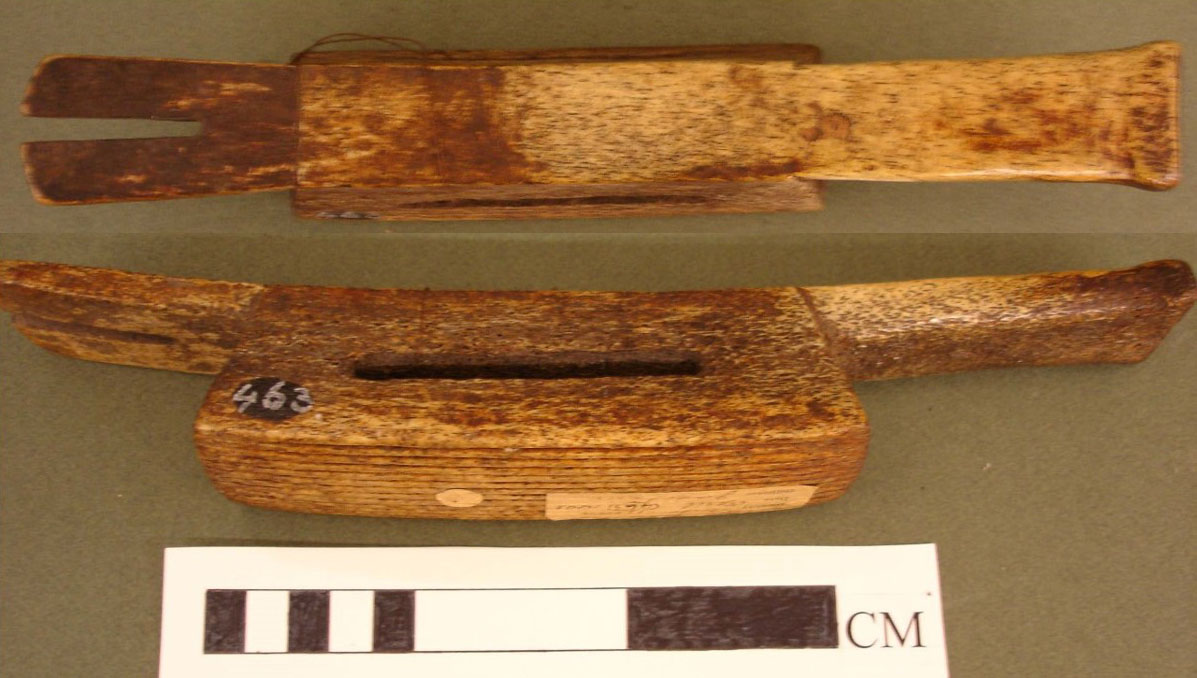
RBCM465. Bella Bella. [“Bella Coola” – old # 108]. Whale bone. Type 2. Whale bone. Collected by Fillip Jacobsen. April 1893.
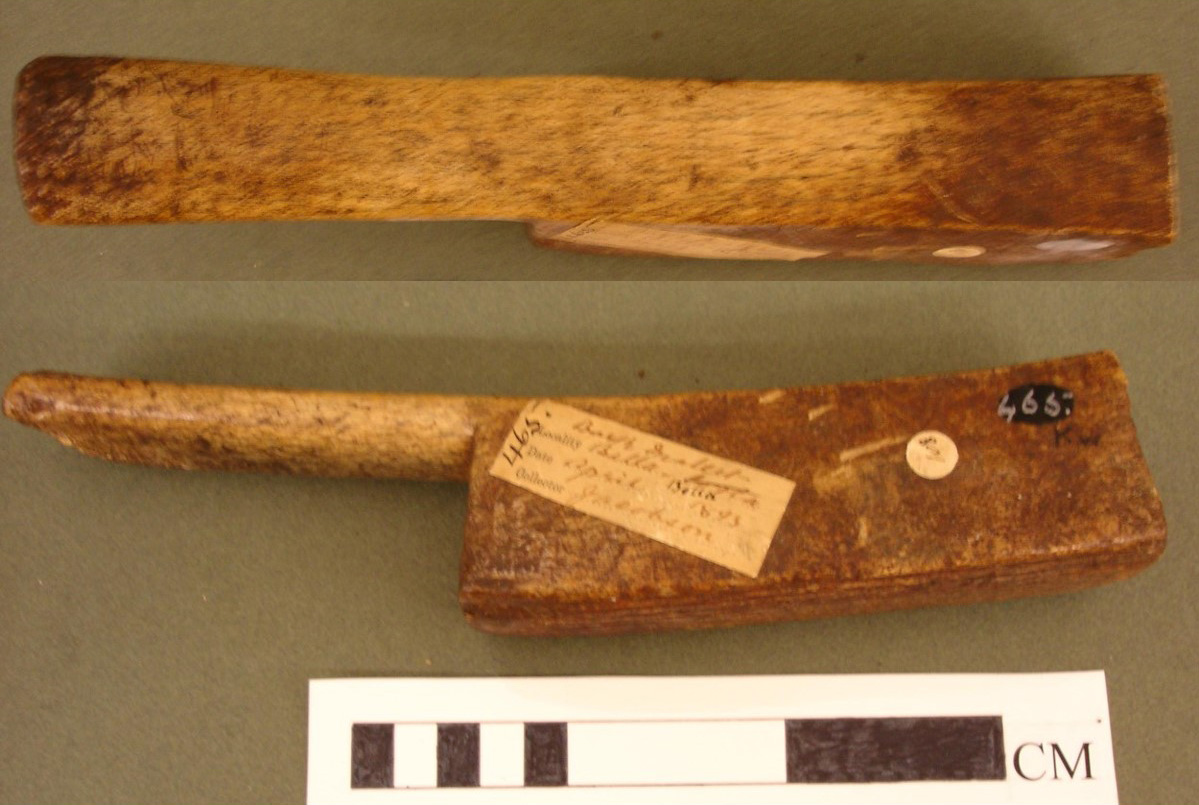
RBCM464. Heiltsuk (Bella Bella). Northern Wakashan. Type 1. Whale bone. Fillip Jacobsen. 1893.
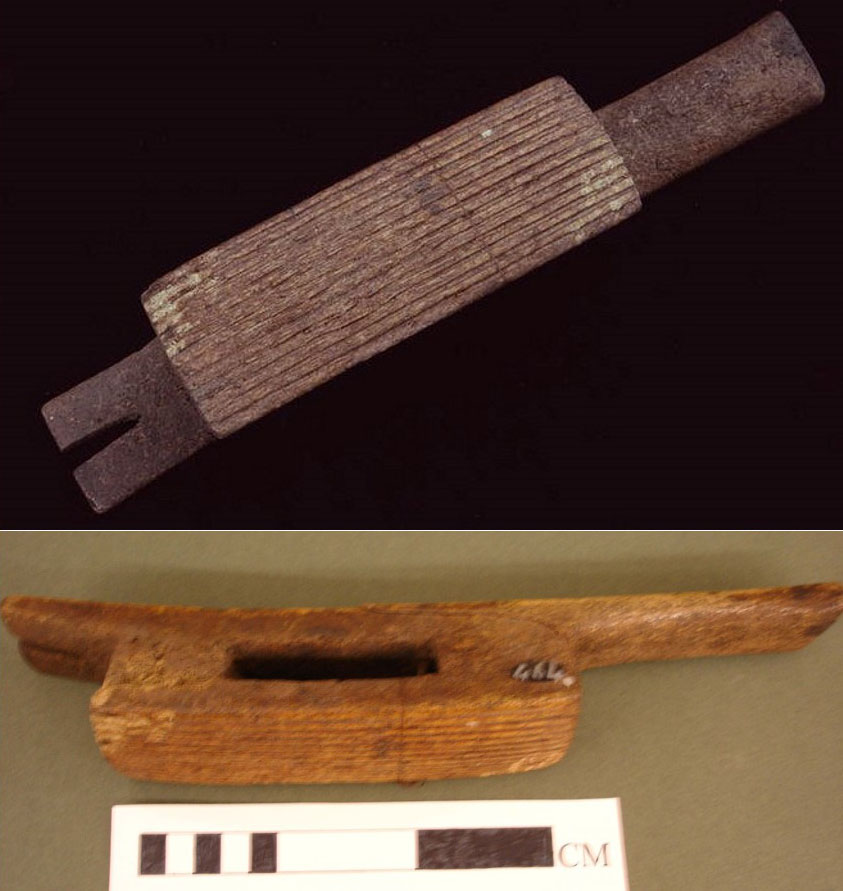
RBCM466. “Heiltsuk, Oyalitoch” (Bella Bella). Northern Wakashan. Type 1. Whale bone. Collected by Fillip Jacobsen. 1893.

Haisla Bark Beaters
There are no Haisla bark beaters in the RBCM collection. Those shown here are from the National Museum of the American Indian collections and the Museum of Anthropology of the University of British Columbia.
Three Haisla (“Kitasoo Xai’xais”) bark beaters in the National Museum of the American Indian, shown n figure 27, include a rare type 1, that is missing a central body hole and a unique type 3 beater, with an upward curving distal end, as well as a type 2.
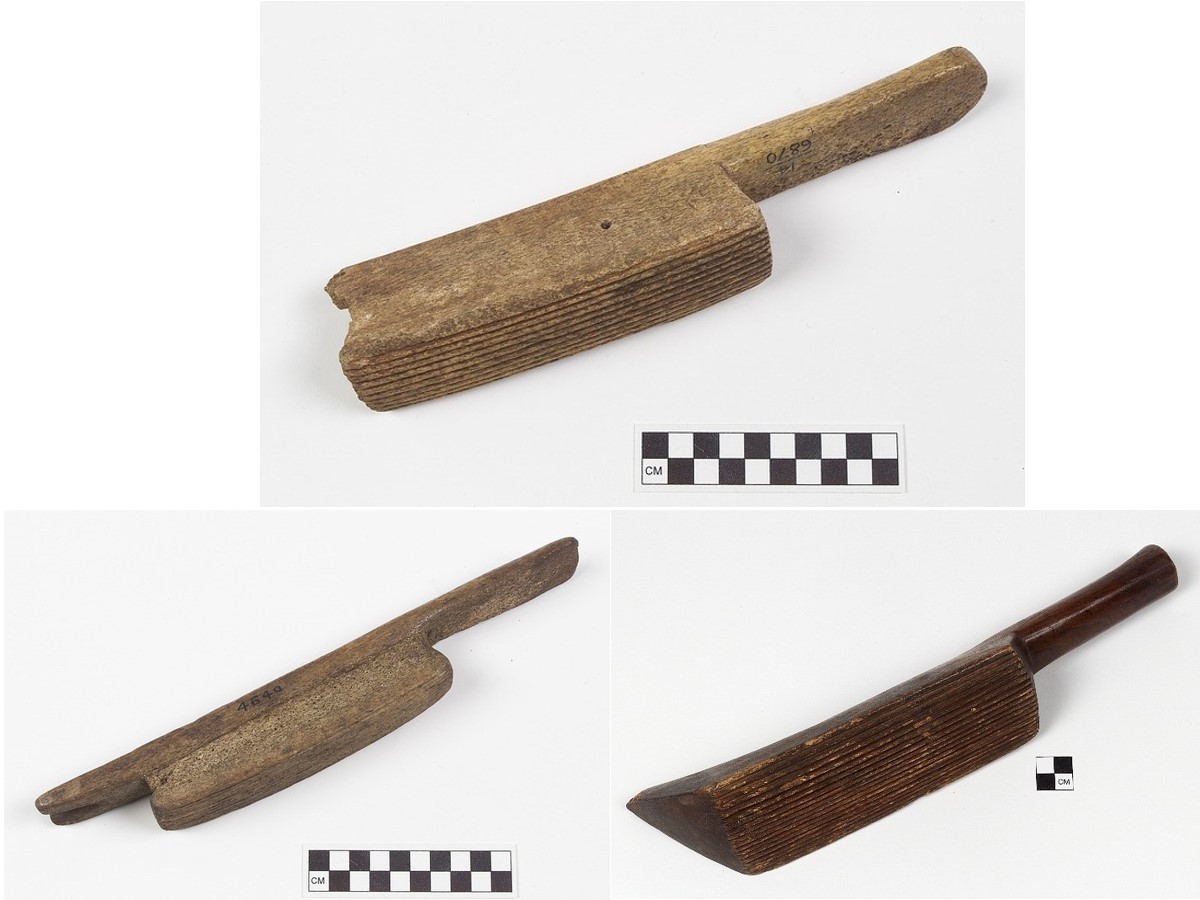
Figure 28, shows three Haisla bark beaters from the U.B.C. Museum of Anthropology collection. The upper example, Moa A 4639, appears weathered and is likely an archaeological example. The two below, A3058 and A3057 are made of hard wood. As they bear a close resemblance to some Polynesian examples, the species of wood should be ascertained to confirm their provenience.

Nuxalk Bark Beaters
There are only two examples of Nuxalk bark beaters, type 1, in the collection of the RBCM. Both were collected by Fillip Jacobson in Bella Coola in 1893. There is a stone artifact, referred to as a Nuxalk bark beater, in the U.S. National Museum of the American Indian, NMAI_4757. It has raised grooves across the bottom rather than longitudinally oriented (Figure 31). It is from king Island, west of Bella Coola. Collected by Bernard Fillip Jacobson (1863-1935), when he was a cannery owner/operator at Bella Coola. Purchased from his wife Helga Thorsen Jacobson (1876-1939), in 1936, with help of William Newcombe (1884-1960) of Victoria.
RBCM468. Nuxalk. Type 1. Whale bone. Collected by Fillip Jacobson. Bella Coola 1893, purchase.
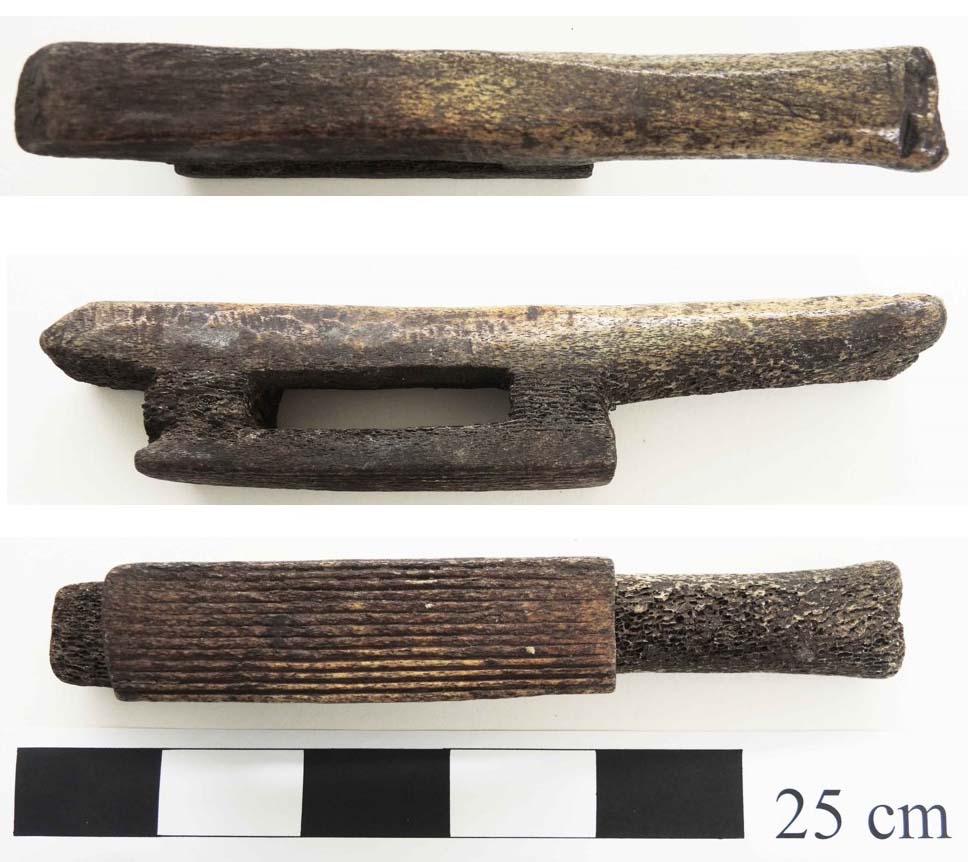
RBCM469. Nuxalk. Type 1. Whale bone. Distal protrusion from surface is not bifurcated. Collected by Fillip. Jacobson. Bella Coola 1893, purchase.
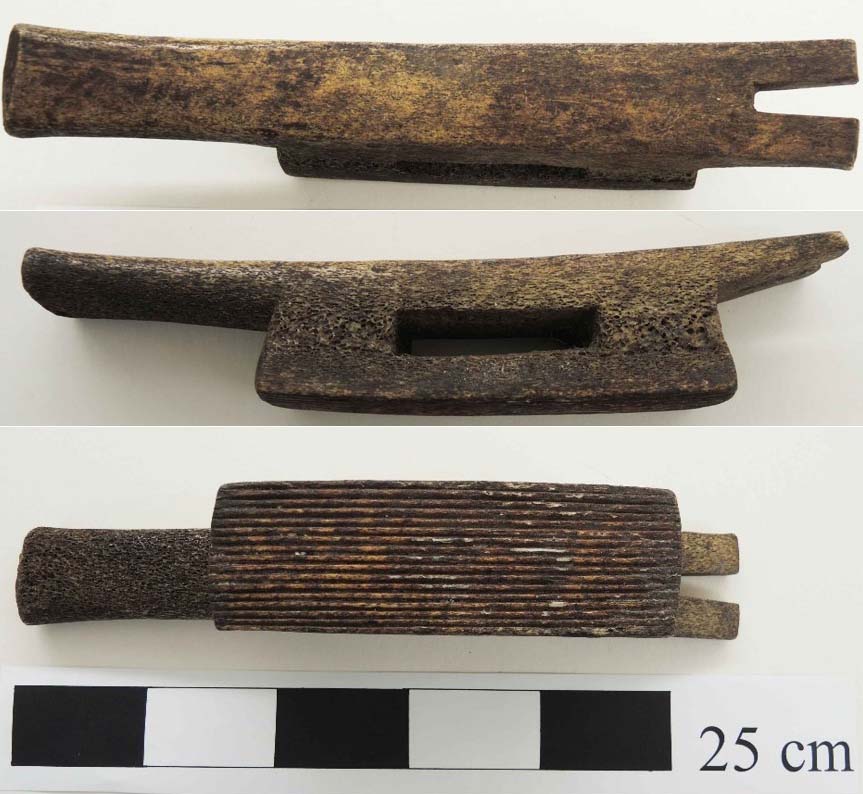

Haida Bark Beaters
There is only one Haida bark beater in the RBCM. One in the NMAI_8576 is listed as “probably Haida”. Given its dubious history from a private collection I would not accept this as being reliable information.
RBCM10639. Haida. Masset. Type 2. This is a unique bark beater with a carved human figure on its top surface (Figure 32 & 33). Two small ear projections (one broken) extend beyond the distal surface. The latter may be part of a head dress worn by the carved figure. From Newcombe estate 1961. Previously in collection of W.A. Jelliman, purchased by Donald McKay and then Charles Newcombe in Feb. 1931. (old number before 0 added “1639”). Whalebone. Weight: 225.7 grams. L. 234mm; W. 36mm; H. 34mm. Handle L. 83mm. Portion of top extending out distal end 22mm. Handle width 28-31mm. Handle height 13-17mm. Grooved base portion of body is L. 129mm; W. 36mm. Eleven raised ridges. A small hole was drilled in the handle – possibly to put a cord through.
This is referred to in the Newcombe Family Add Mss 1077, Vol. 40, Folder 3. C.F. N. 1905, as old #338 and from: “Skidegate. Whalebone. Oblong with small rounded handle, under surface with longitudinal ridges & groves”.
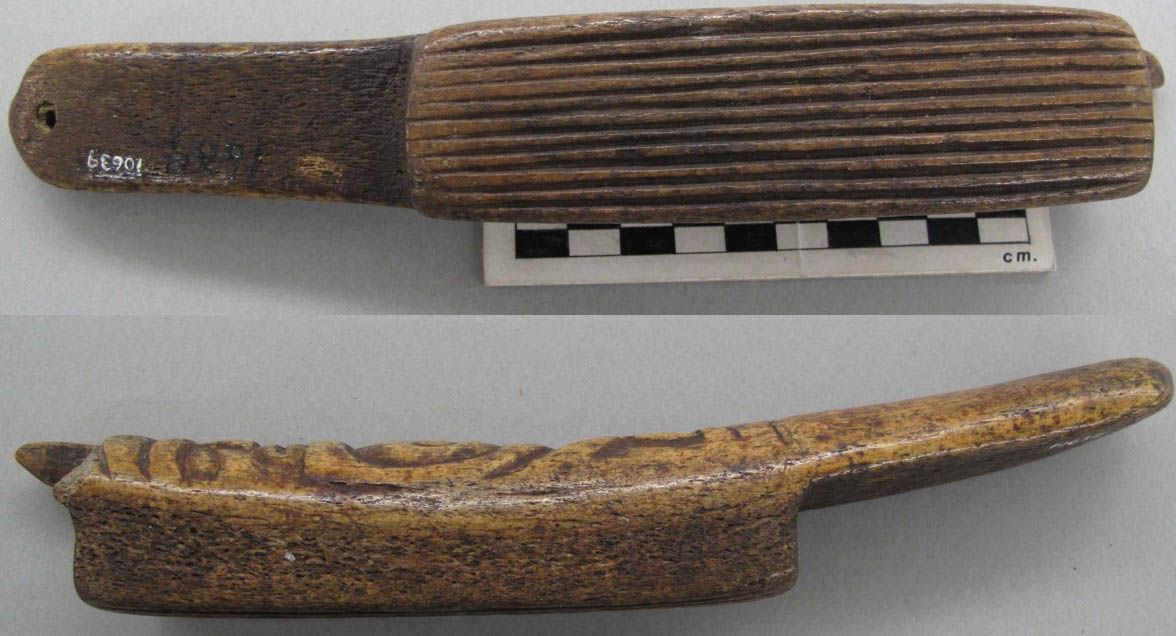
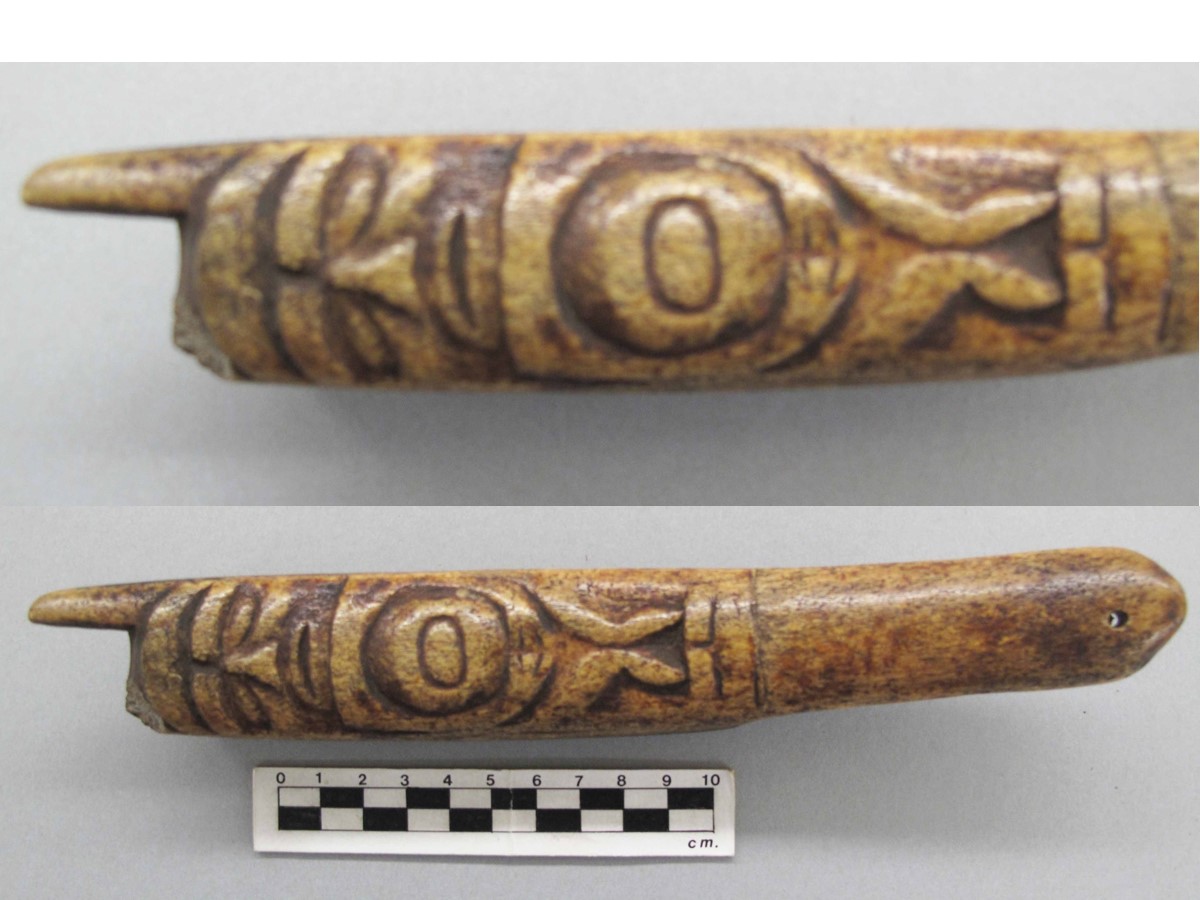
Figure 34, is Haida from the NMAI collection, 1-8092. Collected between 1874 and 1894 by Reverend Thomas Crosby (1840-1914), an English missionary who worked with North Pacific Coast peoples from 1863 to about 1900. Purchased by George Heye from Reverend Crosby in 1908. 34.0 x 7.0 x 5.5 cm
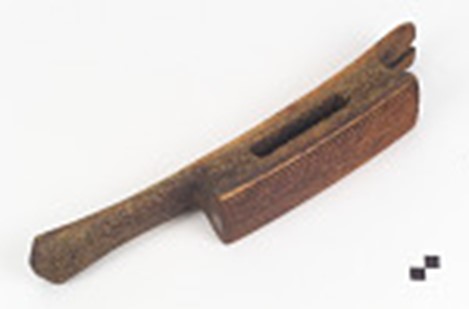
Tlingit Bark Beater ?
There are no examples of Tlingit bark beaters in the RBCM collection. This example is from National Museum of the American Indian collection, 19/3502 (24.5 x 5.0 x 4.7 cm). I suspect this artifact is miss-labelled. There seems to be no evidence of bark beater use in Tlingit territory. This type 2 example, is recorded as “Alaska” and being from the estate of “William M. Fitzhugh Collection”. It was purchased in 1936. Fitzhugh (1853-1929), was a mining and petroleum engineer of San Francisco, who collected a wide variety of artifacts, which were eventually donated to the National Museum of the American Indian and other museums. He worked in Alaska, where he might have collected the beater himself, but the term Tlingit may have been added to the database long after it was collected.
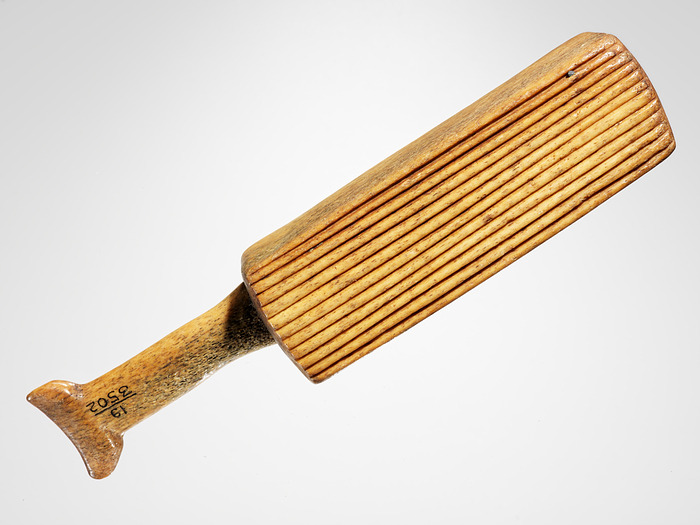
Coast Salish Bark Beaters
There are no bark beater examples in the RBCM ethnology collection from any of the 15 coastal cultural populations belonging to the Salish language family.
In the NMAI collection there is a Type 1, bark beater catalogued as “probably Coast Salish (attributed)” Purchased by collector George Heye from Judge, Archer Martin in 1916. Archer Evans Stringer Martin (1865-1941), lived in Victoria, but collected artifacts from a number of regions. I would treat this example as an unknown.
B.C. General Location Bark Beaters
The following examples can not be identified to a specific cultural population.
RBCM3213. General B.C. Whalebone. Type 3. Flat example with open cellular structure on top. L 31cm W 6.5cm Th 2cm . Handle L 10cm w 3cm Th 2cm.
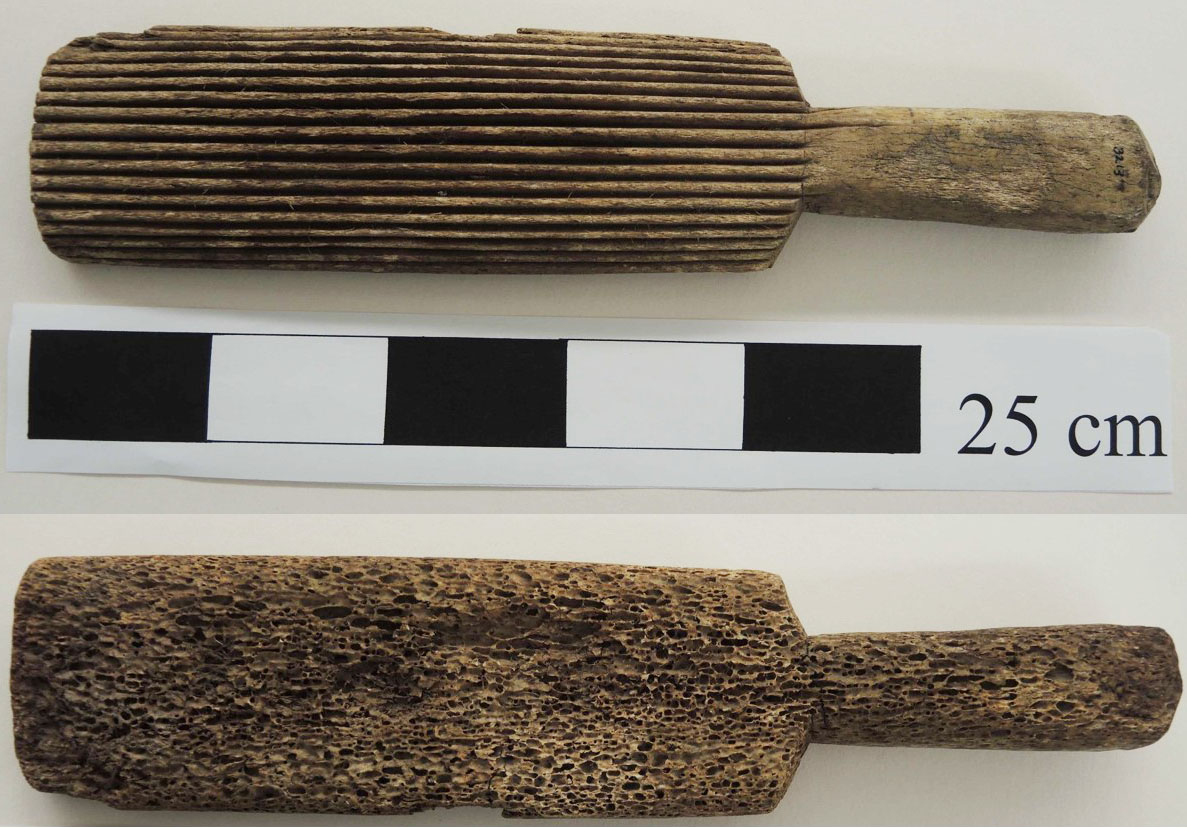
RBCM11541. Location unknown. Whalebone. Bottom central body portion. Broken off handle. Saw cut at bottom. “981” on label.
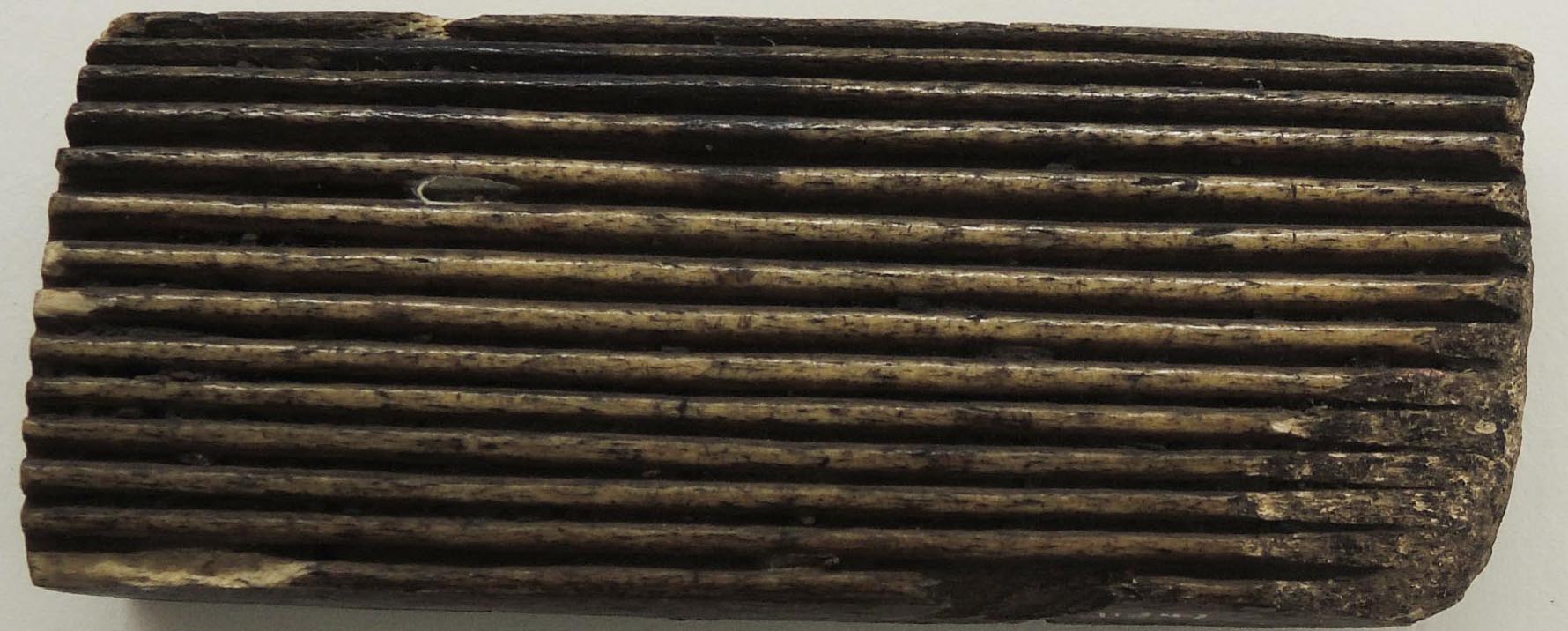
Archaeological Bark Beaters in the RBCM Collections
There are limited examples of bark beaters from archaeological sites, in addition to the few I mentioned, as mistakenly placed in the ethnological collections.
None have been directly radio carbon dated. Some are within a larger stratigraphic layer that has only one or two radio-carbon dates, but uncertainty where the bark beater fits into the sequence. Others can be dated to after a specific time period when there is dating of a basal level or cultural layer in a site. Bark beaters are defined as part of the assemblage of the Queen Charlotte Culture Type in the Johnson Strait area. This culture spans the late period from 1700 to contact, and is speculated by Mitchell to have moved into the region as part of a cultural assemblage from the north. Mitchell illustrates a bark beater from the Hopetown III deposits (Mitchell 1988).
West coast of Vancouver Island
DgSl-61:16. Chesterman Beach. Whalebone. Distal and proximal ends missing. Part of proximal end of tapering handle. Remnants of, at least seven ridges with six groves on the bottom. Grams (77). Max. L. [162mm]; W. 37mm (complete in one place toward one end); H. 28.5mm. Groove widths vary from 3-4mm wide and spaces 1.5-2mm. [24C013]. Collected from a bulldozed midden pile. There are no associated dates on this site.
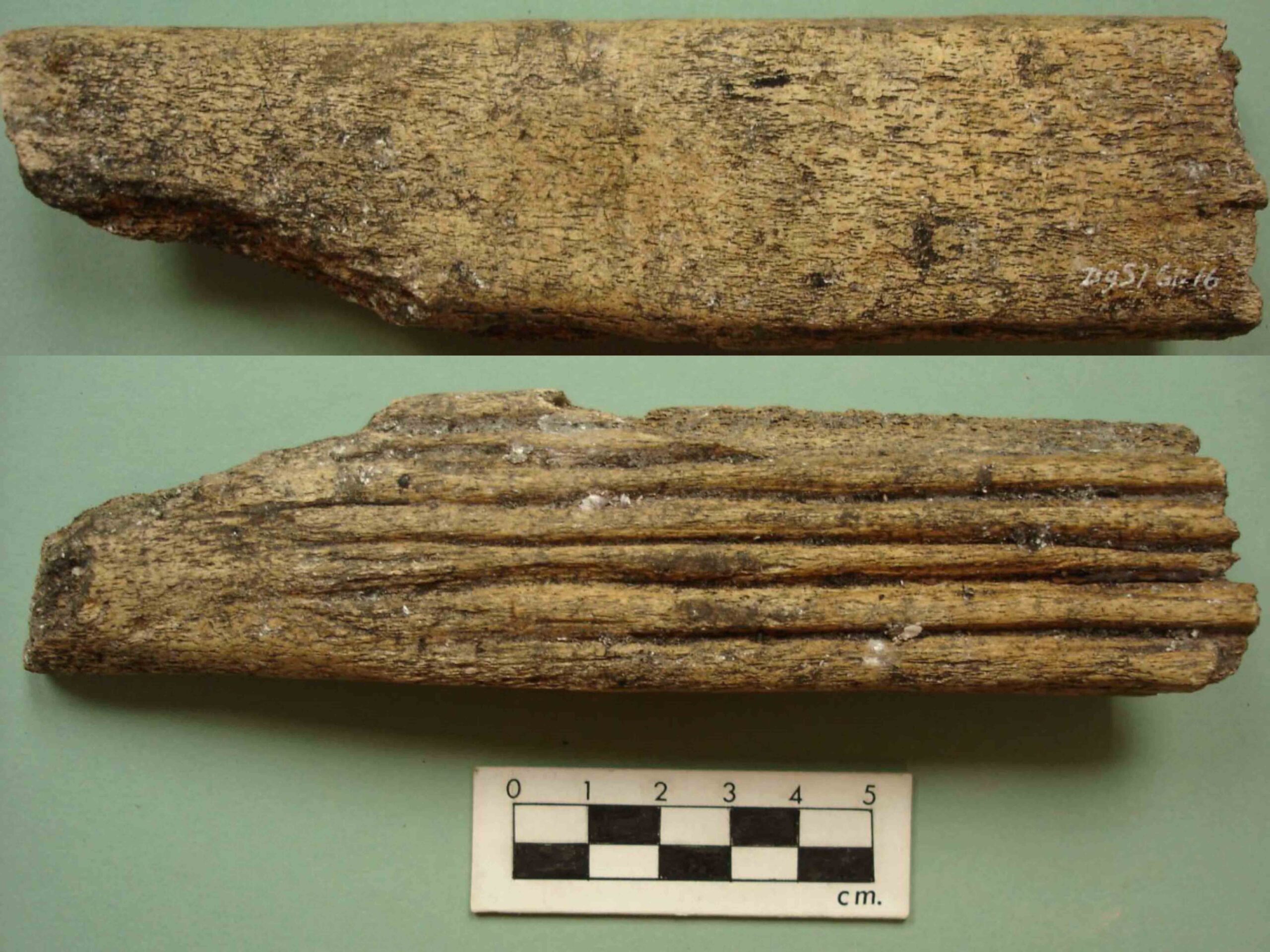
Barclay Sound
Huu-ay-aht Village. DfSh-7.
McMillan and St. Clair describe two bark beater fragments from Huu7ii – House 1: “both are fragmentary, consisting of the rectangular grooved striking surfaces of whalebone bark beaters (Fig. 3-34). One is intact at one end and both sides. It measures 8.8 x 3.8 x 2.8 cm. Six ridges formed by five deeply incised grooves run its length. The other is similar, but is intact only along one side, so is incomplete in both length and width. Three deeply incised grooves remain along the length of this fragment” (McMillan and St. Clair 2012).
Twelve radio-carbon dates were obtained for the house 1 occupation.
“The earliest, with an age range of 970 to 780 cal BP, comes from the charred wood of a hearth in a shallow pit (F42) at the base of the floor. Two other dates provide similar age ranges (Table 3-1). However, three additional dates from the base of the house floor are more recent and non-overlapping, at around 730 to 550 cal BP. Periodic cleaning of the house floor could result in more recent materials being deposited at the same lower level as those reflecting initial use of the house. The final occupation of House 1 is indicated by three dates taken from at or near the surface of cultural deposits, in one case from a hearth feature (F1) and in another from a concentration of FCR (F19). The three dates are very similar (Table 3-1), with age ranges within 550 to 290 cal BP. These three radiocarbon dates intercept the calibration curve at 460, 490, and 520 BP, indicating that house use may have been during the earlier portion of that age span. Final occupation, therefore, was perhaps sometime just over 400 BP.” (McMillan and St. Clair 2012).
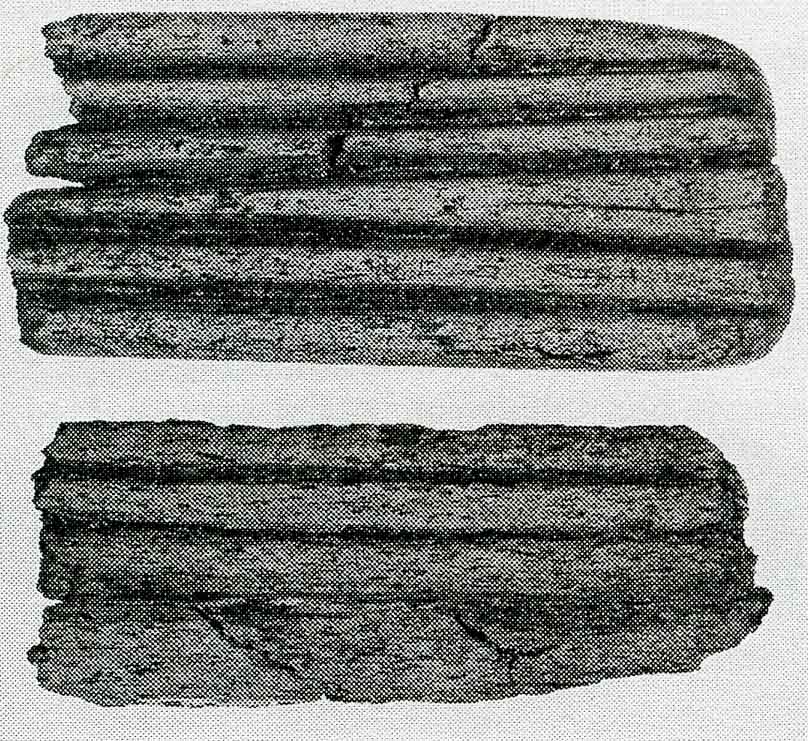
Toquaht Villages
DfSj-23:808. Toquaht village of T’ukw’aa. (McMillan and St. Claire 2005; 1992:51-52; McMillan 1999:174)
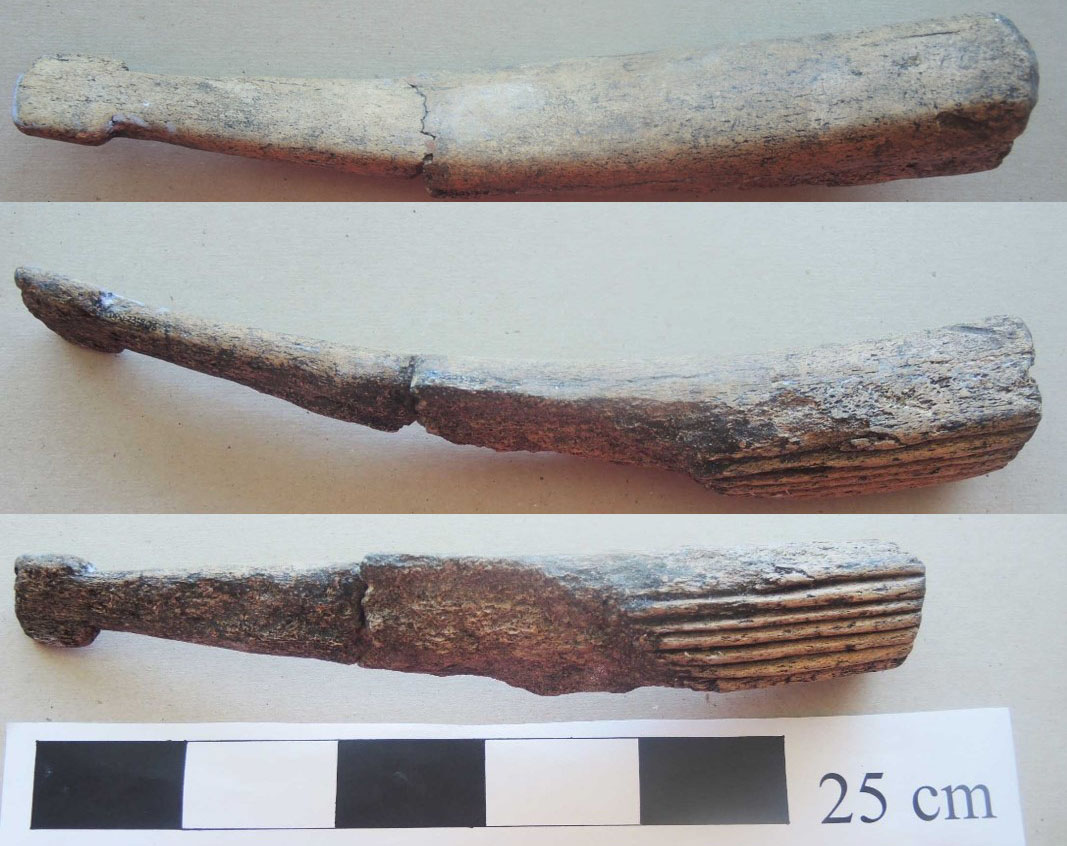
Excavations at Yuquot village DjSp-1.
Excavations at Yuquot village on the west coast of Vancouver Island, revealed two bark beater fragments. John Dewhirst described the two artifacts, IT2J4B-1429 and IT1H10-3412x-1429 (Figure 40):
“Two rigid whalebone artifacts from Zones IIIb and IVb are fragments of striking surfaces of bark beaters. The face of each fragment contains several long parallel ridges. The more intact fragment contains six ridges separated by five grooves (Fig. 99d). The ridges near the more intact end are worn down considerably, but in the less-worn surfaces, the grooves are about 2.5 mm deep. The surface of this artifact, when intact, was about 34 mm wide and more than 150 mm long. The other artifact, a corner fragment of the ridged striking surface (Fig. 99c), is too incomplete to merit measurement. The end and long sides of both artifacts are ground flat and at right angles to the grooved surface. They were thus part of a rectangular base” (Dewhirst 1980:163).
Dating: Zone IIIa, below Zone IIIb where the bark beater was found, has dates of 1082+/–100 B.P. (GAK2194) and 1287+/-100 (GAK2197). Zone IIIc above IIIb, has a date of, 1009+/- 150 (GAK2855). As Dewhirst indicates: “Zone III began to form at ca. A.D. 800”. The second beater fragment is from the uppermost zone IV, which dates to the historic period.
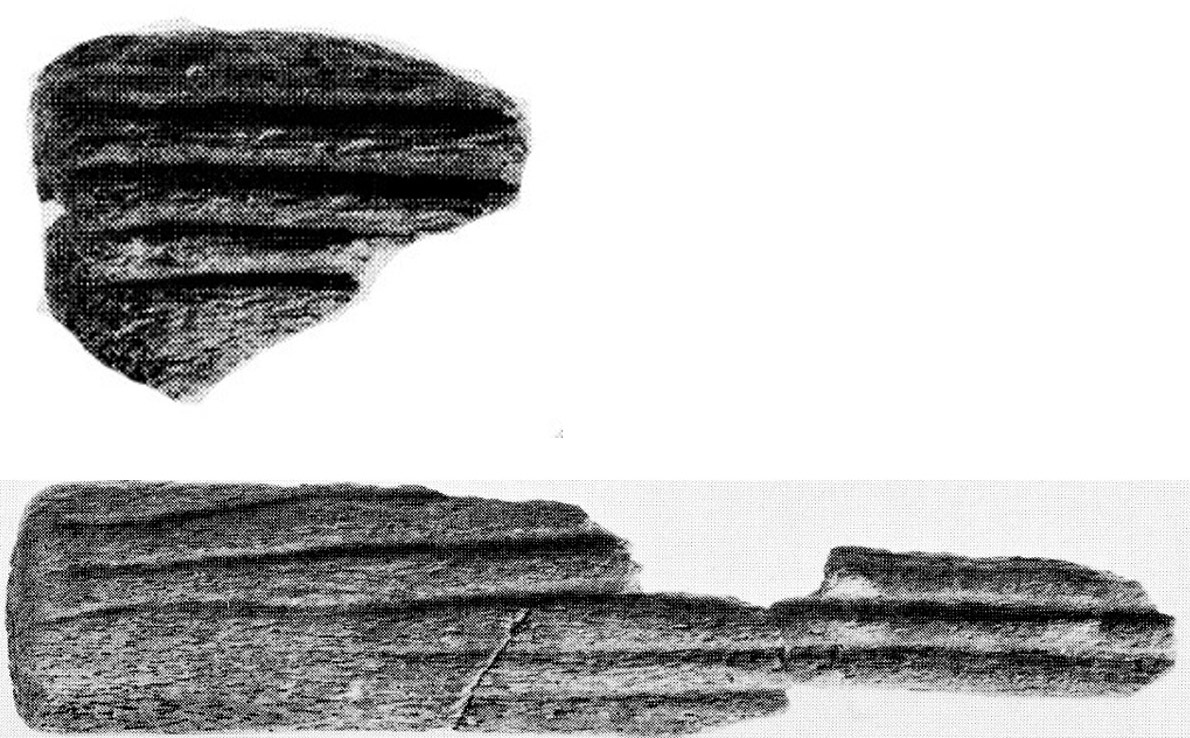
Greater Victoria Region
Esquimalt Harbour.
DcRu-12:3098. Sonhees Reserve. Upper Zone Natural Layer A. Grant Keddie gives the Calibrated date range of 1301 – 1910 A.D., for this Upper Zone.

DcRu-1186:106a-b. Located under water, by dredging, during the Esquimalt harbour Jetty Project It is mostly a bottom portion of the body. Broken in two pieces. A portion of top and proximal end of the handle are intact, as well as an extension from the distal surface over the main body.
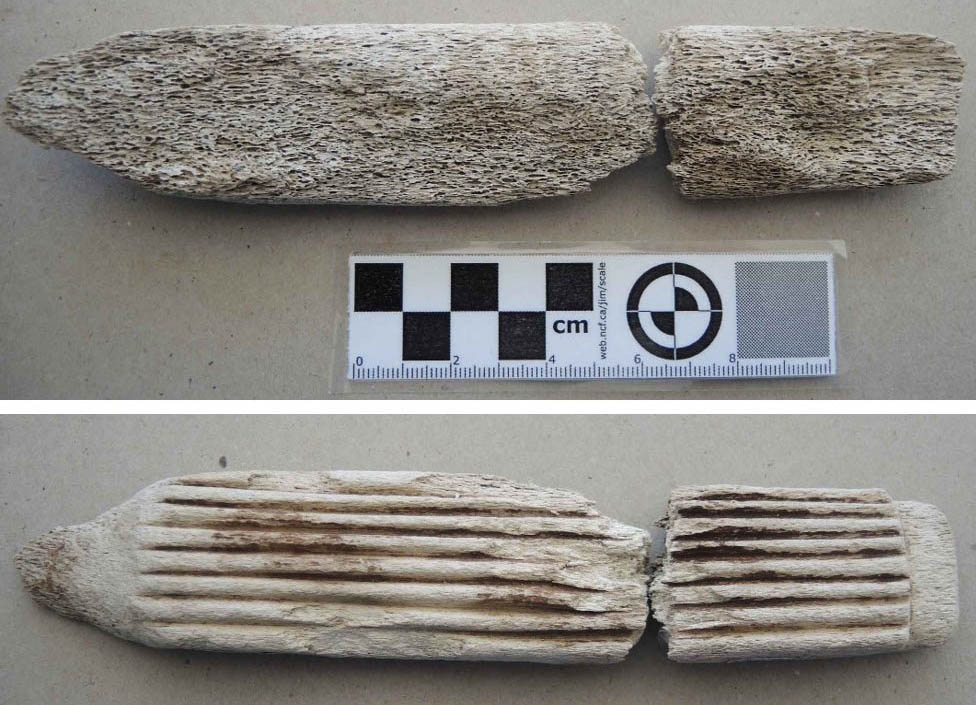
McNeil Bay
DcRt-16:159. (no Image). Distal basal section only. Cross-section of bottom almost complete. Six deep cut grooves. 5mm spacing between grooves. Grams (20.9), Max. L. [79mm]; W. [37mm]; Thickness [15mm]. Sea mammal bone. The author acquired a radio-carbon estimate of 560-+ 65 (WAT 1627, RH86-10, from the deepest layer in this site from a non-permit project. This indicates that the bark beater must be younger than about 1390 A.D. A similar date was recorded at the base of the midden at another location. Reference: Archaeological Excavation & Monitoring DcRt-16, 389 King George Terrace, Victoria, B.C. Heritage Conservation Act Site Investigation Permit 2003-0232 and Heritage Conservation Act Site Alteration Permit 2003-234. I. R. Wilson Consultants Ltd. [Artifact Plate 30, from disturbed context]. (L. 7.8 cm Width 3.74 thickness 1.44cm).
Cadboro Bay
Cadboro Bay Site. DcRt-8:169. Whale bone. Handle part only. Body broken off. L. [148mm]. Tappers from end at 37mm wide and 18mm high to 23mm & 14mm high. [64.6 grams]. There are no radio-carbon dates on this site. The assemblage of artifacts is similar to late period material from other local sites.
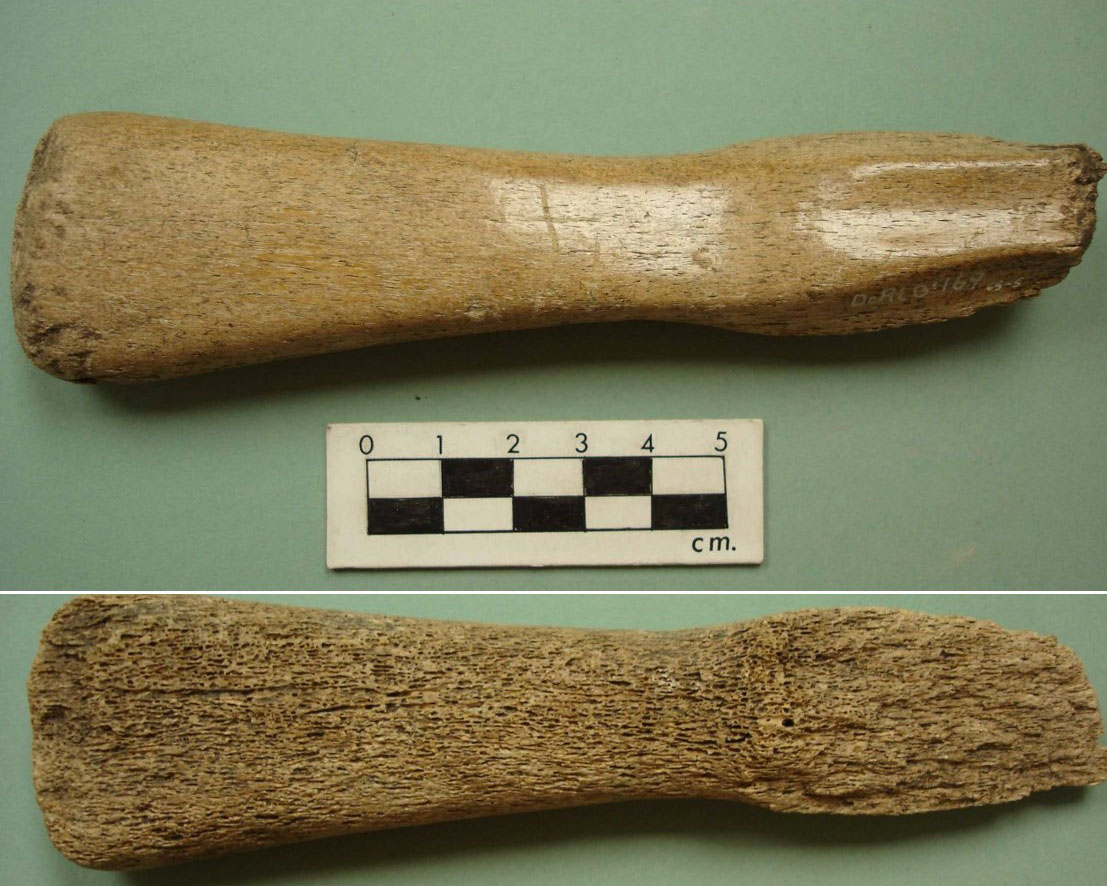
Willows Beach
DcRt-10:4156. (DcRt-10:4157 piece now joined) Willows Beach. Ventral Fragment. L. [81mm]; W. [26mm]. Three grooves c. 2mm wide. Up to 5mm in depth. Two adjoining pieces on side present. From Level Bags N8-10 E38-40 F/60-70. Box 2863. Excavations of Ray Kenny (1970-71). This is from the late period upper levels.
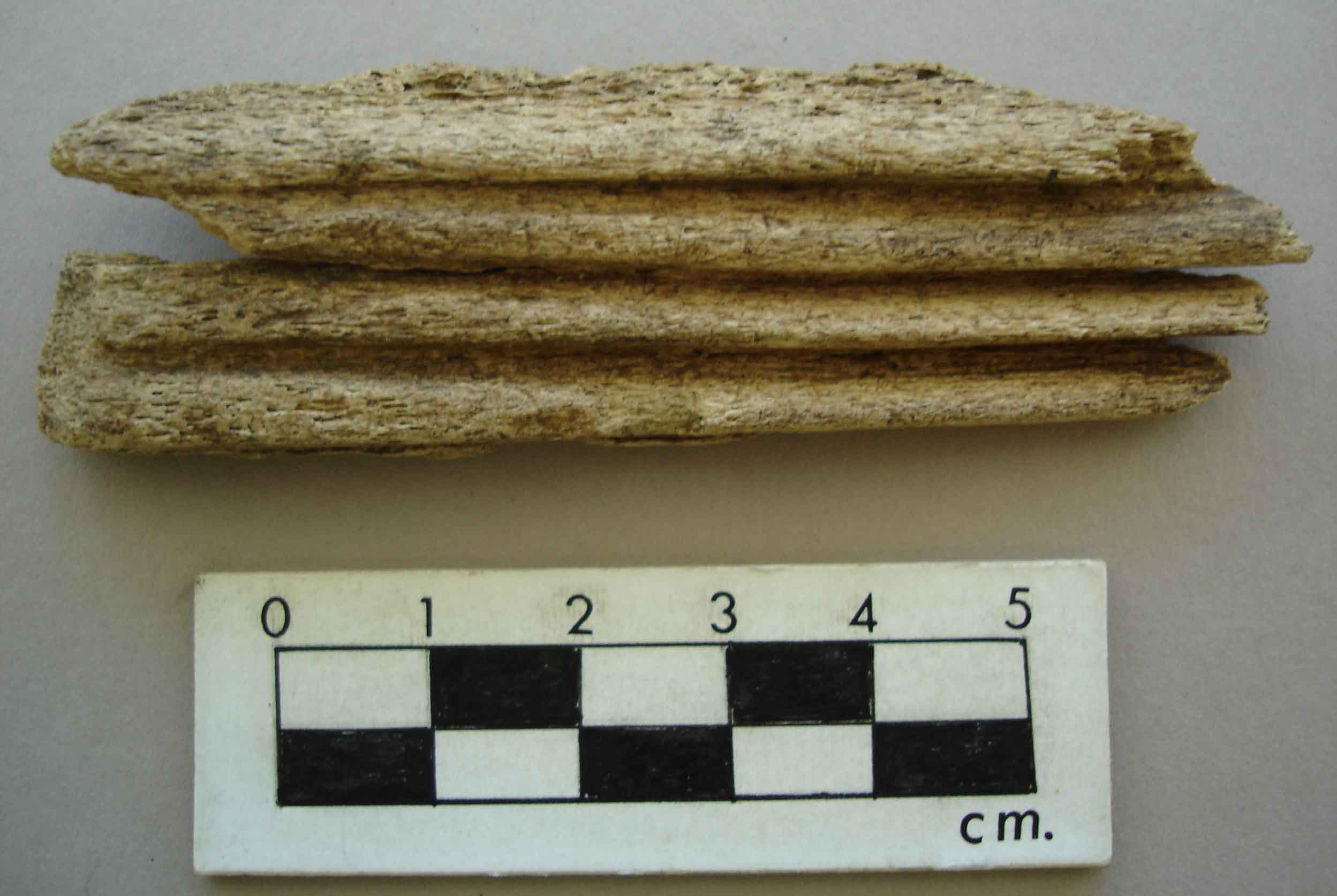
Esquimalt Lagoon
DcRu-74:154. Fragment of base only. From undated shellmidden below Lagoon Road near its intersection with Ocean Boulevard. These deposits are defined as a: “Late prehistoric occupation …this occupation may have been approximately contemporaneous with village site DcRu-2 at the northern end of the Esquimalt Lagoon, which was first occupied 1200 years BP. (Mathews and Dady 2004).
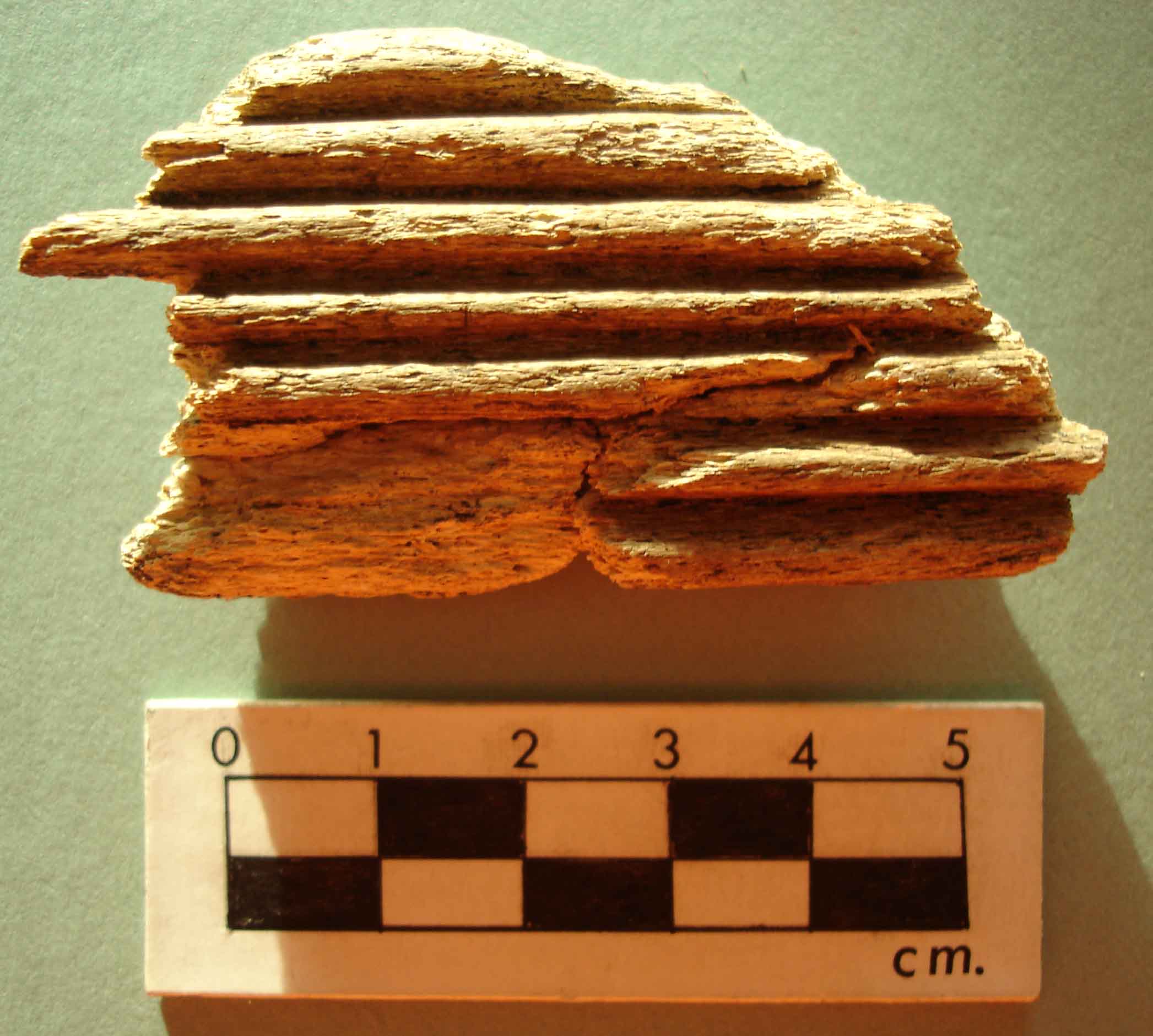
Pedder Bay
DcRv-1:519a&b. L. [125mm]. Bottom width incomplete [31mm], original c. 33mm. Top width 24mm (tappers to base). Ground on top and sides. Nine ribs present. Original 10 or 11 ribs. Rib widths 2mm. Grams [65.2]. [09B019].
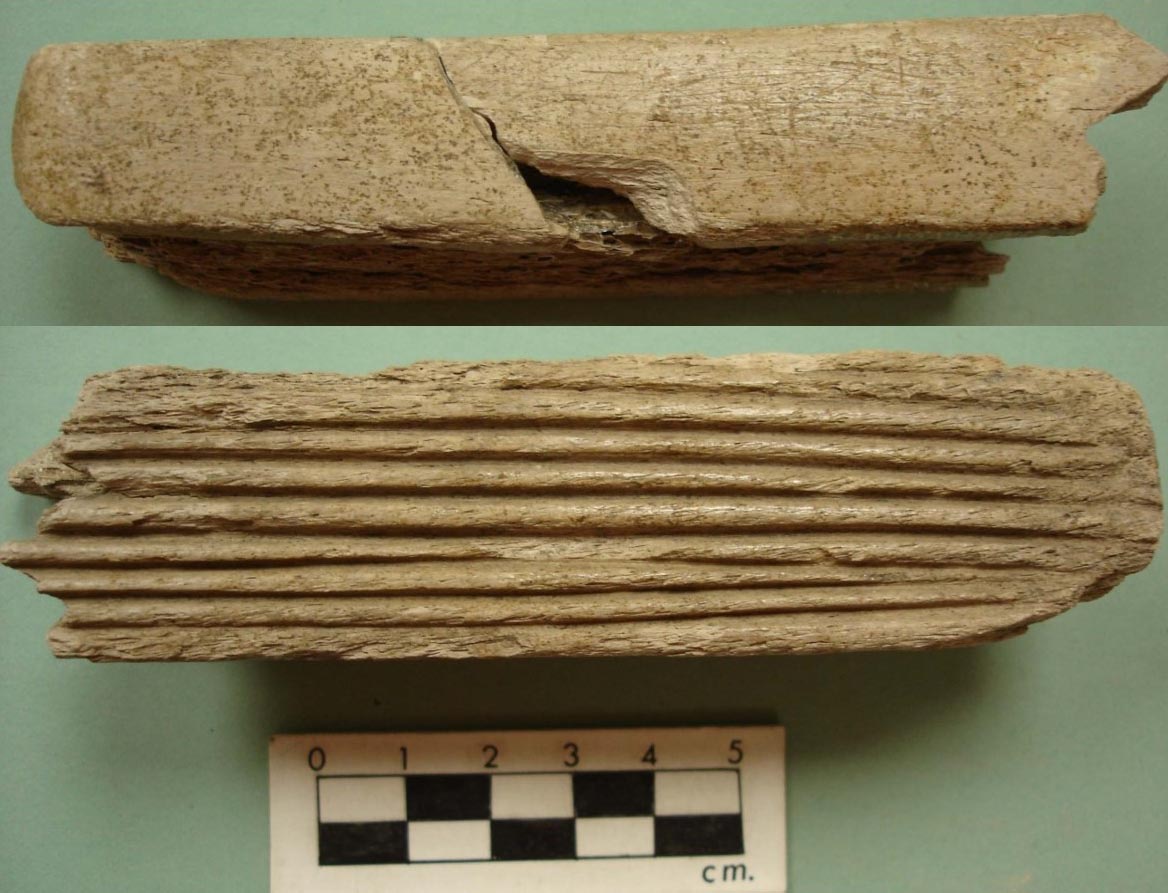
Tsimshian Language Family Territory
A unique fragment of a sandstone artifact, GbTo-31:X-896, has a grooved surface like the whalebone bark beaters (Figure 47). It is too fragmentary to determine what it is. There are no known historic ethnographic equivalents to this artifact among the Tsimshian language family speckers. Canadian Museum of History, Catalogue number GbTo-31 (Length 40.6 mm, Width 39.8 mm, Thickness 27.9 mm). The specific dating is not known. It is listed as being somewhere between c. 1000 B.C. and c. A.D. 1000.
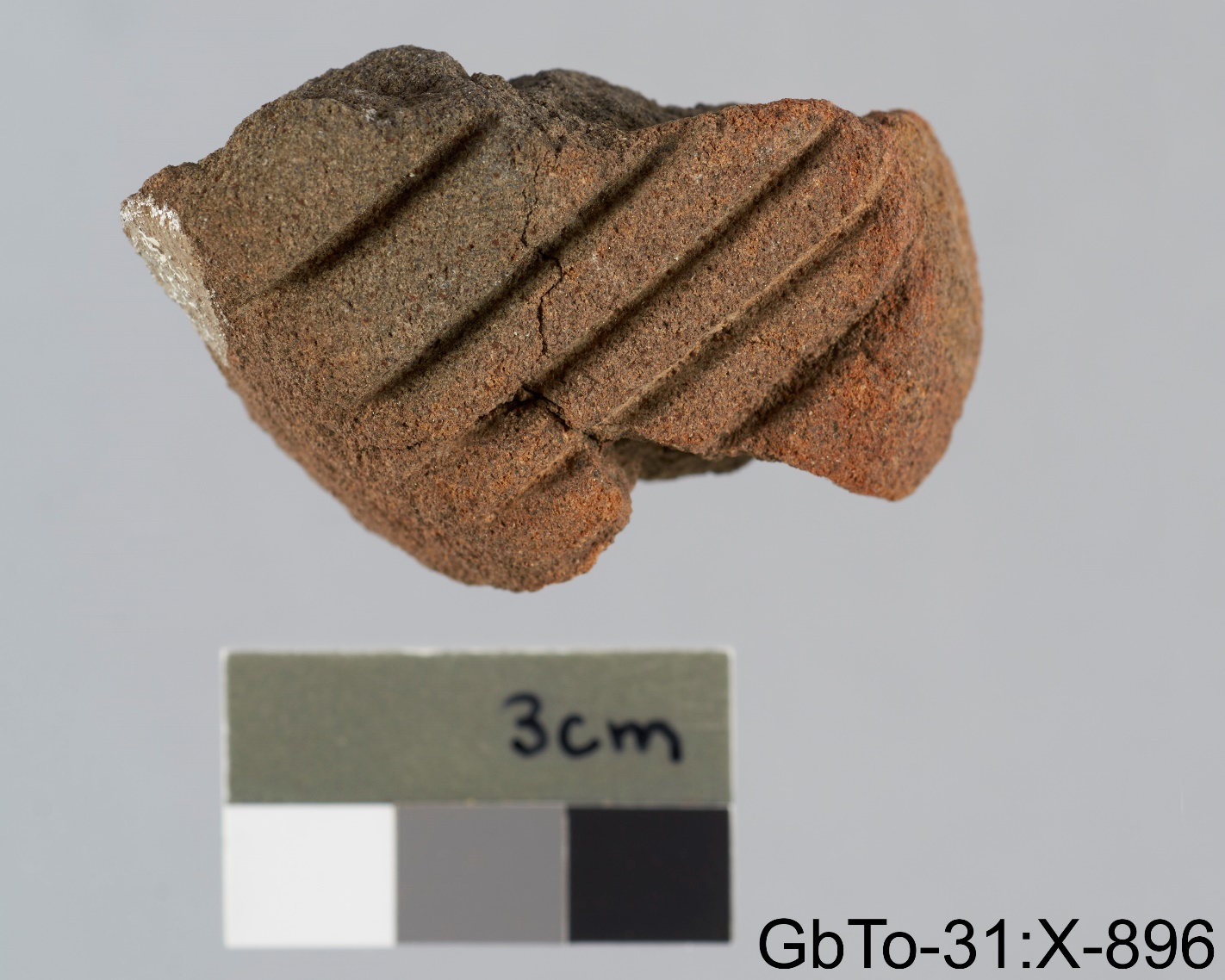
Discussion
Bark beaters are found primarily within parts of the historic territories of speakers within the Wakashan Language family. This includes the southern Wakashan; Nuu-chahn-nulth, Maka and Ditidaht; and in the Northern Wakashan Haisla, Heiltsuk, Kwakwala and Oowekyala. The movement of some of these peoples into the territory of others in late precontact times may have played a role in the movement of bark beaters into new regions, where they became part of the ethnographic record. In the latter case, they may not be expected to be found in archaeological sites until later time periods (see McMillan 1998; 2003 and Mitchell 1988).
One of the problems in undertaking an analysis of both ethnographic and archaeological artifacts, is a combination of the lack of adequate numbers and/or their associated contextual information. This is certainly true regarding examples from British Columbia. The day will come when we will be able to do so much more by accurate dating and undertaking both DNA and isotopic analysis of the whale bone beaters, to compare with whale bones from various sites, and to link them with current and extinct lineages of whales. It will be useful to show if the bark beater DNA matches bones from the site they are found on, or to link them to another site location where the artifacts may have been manufactured.
Another problem with older museum collections is the reliability of the information regarding the history and context of the artifacts. This especially true if they have gone through several hands in their history, with people that are more interested in selling them than maintaining the integrity of the information. I suspect information is wrong on two of the three bark beaters from the U.B.C. Museum of Anthropology collection, labelled as Haisla (Figure 28). These are noted as dating to the early 1900s. Artifact A4369, of whale bone, at the top of figure 28, is like other type 1 beaters from British Columbia, but the other two wooden ones, A3058 and A2213, below on figure 28, show a strong similarity to bark beaters from the Solomon Islands. The two appear to be made of a non-local hard wood. I suspect they are from the Solomon Islands. U.B.C. has a variety of beaters from the Solomon Islands and other Pacific Islands. A future DNA identification of the wood will solve this question. The artifact seen in figure is listed as Tlingit, but there seems to be no evidence that Tlingit populations used this kind of tool.
One might expect bark beaters to be present throughout the larger area where red and yellow cedar occur, especially to the north into Alaska. The best information on bark beaters in British Columbia ethnographic collections, at present, is from the central west coast and northeast coast of Vancouver Island. The best archaeological information, is currently from the west coast of Vancouver Island and the greater Victoria region.
There are no details on how the different styles of bark beaters may have been used in the process of preparing the bark. The type 3 beaters are lighter and would be more easily broken if pounded too hard. However, I suspect that they were used later in the finer processing of the bark or for the specialized processing of specific bark material products. It also needs to be considered that the lighter type 3, was used for preparing other raw material such as the preparation of nettle. Koppert notes in his description of the making of the type 1 bark beater among the Clayoquot, that the rectangular hole in the body “is cut out with the small chisel” (Koppert 1910). From my own experience of working bone, I would suggest that the chisel would need to be one with an iron or steel blade. This would suggest that Type 1 beater was only made after the introduction of iron tools (see Keddie 2006).
Conclusions
Whalebone bark beaters appear to be earliest on the West Coast of Vancouver Island. They appear to be present by, at least, around 1080 A.D. It would be of benefit in the future at have radio-carbon dates directly from the whalebone bark beaters to be more exact in dating their first appearance on the coast of B.C. The current archaeological sample of bark beaters is very small. This is a result of the fact that so many areas of the coast of British Columbia have not had a sufficient amount of archaeological work.
There is not enough information, at present, to indicate that bark beaters represent a transfer of an artifact type from Polynesia to the coast of B.C. If the latter were true, one might expect that they would be part of an assemblage of other kinds of artifacts that appeared near the same time. There are a number of candidates for the later that are in need of further examination.
Appendix 1. Paul Tolstoy’s Ideas:
The quotes below come from Paul Tolstoy’s 1991:8-12, Paper Route publication.
“My own survey of hundreds of specimens of the club and racquet types [of bark beaters] shows further correspondences in the construction of Mesoamerican and Indonesian examples. … My research also reveals a pattern of dates for the archaeological examples. In Mesoamerica, the earliest bark beaters are from the Maya area and its periphery, particularly the Pacific coastal plain of Guatemala and El Salvador, where they appear some 2,500 years ago”.
“The dating of artifacts from the islands of Southeast Asia is less secure, but both forms [of bark beaters, i.e. club-shaped, and
racquet-type] almost certainly go back several hundred years earlier than they do in Mesoamerica. In Taiwan they probably go back one or two thousand years still earlier”.
“Surveying the manufacturing technologies of bark cloth and early true paper worldwide, I have identified some 300 variable features in the steps that go into producing these materials. They include such elements as the cultivation or care of trees used for their bark; ways of getting at the desired bast layer, … [a long list of such features follows here]”.
“In addition, I have recorded some 140 uses of the product, such as mats, blankets, bags, various items of clothing, shrouds, banners, and of course, writing paper.” – “Finally, there are some 100 specific details of the design of bark beaters, which may be combined in various ways, and a mass of relevant botanical and linguistic information”.
“Finally, the shared features and innovations suggest a family tree for these industries with a history of common inheritance and local
differentiation. In it, Mesoamerican paper technology evolves from a prototype shared with Sulawesi bark cloth and moves toward the threshold of the true papermaking. Evidence from China suggests that this threshold was crossed sometime between 2,500 and 2,000 years ago, possibly in southern China or Indochina. Mesoamerica, however, acquired a version of the technology as it existed just prior to this event, probably from the area that includes Indochina, Taiwan, and the Philippine Islands, where the two beater forms occur together archaeologically”.
References
Allen, M. S. (2014) “Marquesan Colonisation Chronologies and Post Colonisation Interaction: Implications for Hawaiian origins and the ‘Marquesan Homeland’ hypothesis”, Journal of Pacific Archaeology, 5(2), pp. 1–17.
Anderson, A. J., Conte, E., Smith, I. and Szabo, K. (2019) “New excavations at Fa’ahia (Huahine, Society Islands) and chronologies of central East Polynesian colonization”, Journal of Pacific Archaeology, 10(1), pp. 1–14.
Bellwood, Peter. 1979. Neolithic and Early Metal Age Cultures in the Southeast Asian Mainland. pp. 153-232. In: Man’s Conquest of the Pacific. The Prehistory of Southwest Asia and Oceania. Oxford Press, New York.
Blench, Roger; 2014. The Austronesians in the New World: a Chronostratigraphy. 2014 International Conference on Formosan Indigenous Peoples: Contemporary Perspectives.15-17 September 2014, Academia Sinica, Taipei, Taiwan.
Boas, Franz. 1909. The KwaKiutl of Vancouver Island. Memoirs of the American Museum of Natural History. Vol. 8, No. 2.
Boas, Franz. 1921. The Ethnology of the Kwakuitl. 35th Annual Report of the Bureau of American Ethnology to the Smithsonian Institute. 1913-1914. Part 1. Washington Government Printing Office. Pp. 43-794.
Buck, Peter H. (Te Rangi Hiroa). 1957. Arts and Crafts of Hawaii. Bernice P. Bishop Museum Special publication 45. Honolulu.
Brigham, W. T. 1911. Ka Hana Kapa: The Story of the Manufacturing of Kapa (Tapa), or Bark-Cloth, in Polynesia and Elsewhere, but Especially in the Hawaiian Islands. Memoirs of the Bernice P. Bishop Museum 3:1-273.
Cranston, B. A. L. 1961. Melanesia. A Short Ethnography. British Museum, Charles Skilton Ltd., London
Dewhirst, John, 1980. The Indigenous Archaeology of Yuquot, a Nootkan Outside Village. The Yuquot Project. Vol. 1. History and Archaeology 39. National Historic Parks and Sites Branch. Parks Canada.
Drucker, Philip. 1951. The Northern and Central Nootkan Tribes. Smithsonian Institution, Bureau of American Ethnology. Bulletin 144. United States Printing Office, Washington.
Ellis, William. 1782. An Authentic Narrative of a Voyage Performed by Captain Cook, in his Majestie’s Ships Resolution and Discovery, during the hY*ears 1776, 1777, 1778, 1779 and 178, in search of a North-west Passage between the continents of Asia and America. Vol. 2, G. Robinson, J. Sewell and J. Debrett, London.
Feher, Joseph. 1969. Hawaii: A Pictorial History. Bernice P. Bishop Museum Special Publication. No. 58. Bishop Museum Press, Honolulu.
Force, Roland and Force, Maryanne, Art and Artifacts of the Eighteenth Century, Honolulu, 1968.
Jewitt, John, The Adventures and Sufferings of John R Jewitt. Captive Among the Nootka. 1803-1805, [1824], in Derek G Smith (ed.), The Carlton Library, vol. 76, Toronto, 1974.
Heyerdahl, Thor. 1975. The Art of Easter Island. Doubleday & Company, Inc., Garden City, New York.
Heyerdahl, Thor. 1952. American Indians in the Pacific. The Theory behind the Kon-Tiki Expedition. Printed in Sweden by Victor Petersons Bokindustriaktiebolag, Stockholm, Published by George Allen & Unwin Ltd. London.
Hoëm, Ingiert (ed). 2014 Thor Heyerdahl’s Kon-Tiki in New Light, Volume 14. The Kon-Tiki Museum, Occasional Papers.
Kaeppler, Adrienne L, ‘Artificial Curiosities’ Being an Exposition of Native Manufactures Collected on the Three Pacific Voyages of Captain James Cook RN [Exhibition catalogue], Bishop Museum Press, Honolulu, 1978a.
Kaeppler, Adrienne L, Cook Voyage Artifacts in Leningrad, Berne and Florence Museums, Bishop Museum Press, Honolulu, 1978b.
Keddie, Grant. 2006. The Early Introduction of Iron Among the First Nations of British Columbia. Royal B.C. Museum.
Keddie, Grant 1976. Preliminary Report on the l976 Maplebank Project‑Excavations at DcRu l2. Heritage Conservation Branch Permit # ‑l8.
Kennedy, Raymond. 1934. Bark Cloth in Indonesia. Journal of the Polynesian Society. Vol. 43, No. 4 (172):229-243.
Kooijman, Simon. 1972. Tapa in Pol ynesia. Bernice P. Bishop Museum Bulletin 234. Honolulu.
Koppert, Vincent. 1910. Contributions to Clayoquot Ethnology. The Catholic University of America. Anthropological Series. No.1.
Lennard, Francis and Andy Mills. (editors). 2020. Material Approaches to Polynesian Bark Cloth. Cloth. Collections. Communities. Sidestone Press, Leiden.
Mathews and Dady 2004. Excavation and Monitoring at DcRu-74: Colwood Trunk Sewer Phase V, South Esquimalt Lagoon, HCA Site Alteration Permit 2002-398 Millennia Research .
McIlwrath, T. F. 1948 The Bella Coola Indians. University of Toronto Press.
McMillan, Alan. 1998. Changing Views of Nuu-chah-nuth History: Evidence of Population Replacement in Barkey Sound.Canadian Journal of Archaeology.22(1):5-18.
McMillan, Alan D. and Denis E. St. Claire. 2005. Tsʼishaa: Archaeology and Ethnography of a Nuu-chah-nulth Origin Site in Barkley Sound. With appendices by Susan Crockford, Gay Frederick, Martin Magne, Iain McKechnie, Ian Sumpter and Michael Wilson. Archaeology Press, Simon Fraser University, Burnaby.
McMillan, Alan D. 2003. Reviewing the Wakashan Migration Hypothesis.. In: Emerging from the Mist: Studies in Northwest Coast Culture History, edited by R.G. Matson, Gary Coupland, and Quentin Mackie, pp. 244–259. UBC Press, Vancouver.
McMillan, Alan D. and Denis C. St. Clair. 2012. Huu7ii: Household Archaeology at a Nuu-chah-nulth Village Site in Barkley Sound. With appendices by: Gay Frederick, Iain McKechnie, Ursula Arndt, Dongya, Ian D. Sumpter Beth Weathers, and Marlow G. Pellatt. Archaeology Press, Simon Fraser University, Burnaby.
McMillan, Alan D. 1999. Since The Time of the Transformers: The Ancient Heritage of the Nuu-chah-nulth, Ditidaht, and Makah. University of British Columbia Press, Vancouver
McMillan, Alan D. 1992 The Toquaht Archaeological Project: Report on the 1992 Field Season. Report Submitted to the British Columbia Heritage Trust and Archaeology Branch, Victoria, and the Toquaht Band, Ucluelet, British Columbia
Mitchell, Donald. 1988. Changing Patterns of Resource Use in the Prehistory of Queen Charlotte Strait, British Columbia. In: Research in Economic Anthropology, Supplement 3:245-290
Rolett, B. and Dye, T. (2024) “Polynesian settlement of the Marquesas Islands: The chronology of Hanamiai in comparative context”, Journal of Pacific Archaeology, 13(2)
Tolstoy, Paul. 1963. Cultural Parallels between Southeast Asia and Mesoamerica in the manufacture of bark cloth. Transactions of the New York Academy of Science, series II, vol. 25, 646-662. New York.
Tolstoy, Paul. 1991. Paper Route. Were the manufacture and use of bark paper introduced into
Mesoamerica from Asia? Natural History, June 1991:6-14.
Tolstoy, Paul. 2008. Barkcloth, Polynesia and Cladistics: An Update. The Journal of the Polynesian Society. 117:1:15-57. Published by: The Polynesian Society.
Weisler, M., Sinton, J., Hua, Q. and Skippington, J. (2023) “Indirectly Dating one of the Oldest Adze Quarries in the Hawaiian Islands Provides Insights into the Colonisation Process and Community Networks”, Journal of Pacific Archaeology, 13(2).
